Corporate Accounting Report: Retail Company Financial Analysis
VerifiedAdded on 2020/11/23

Paraphrase This Document
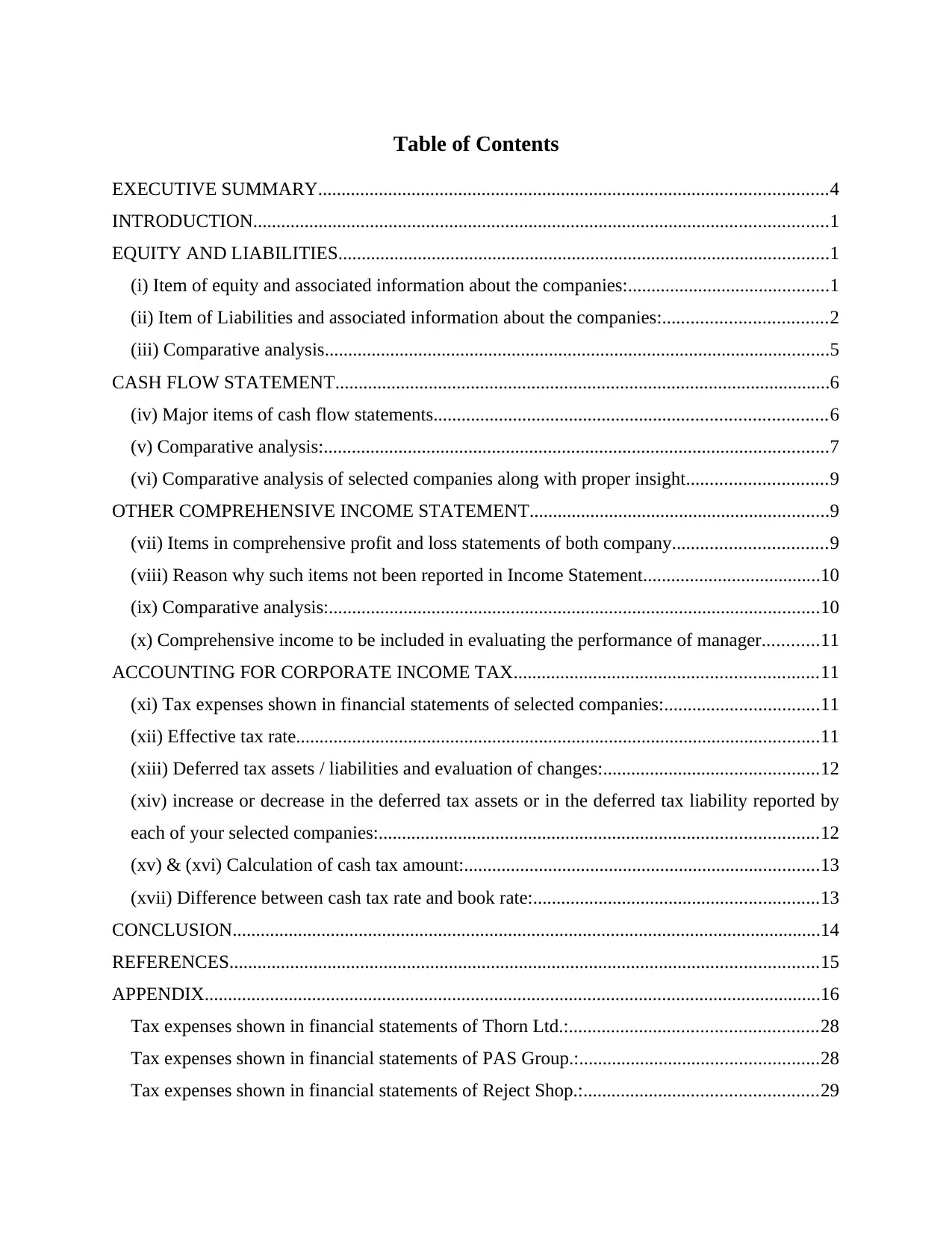
EXECUTIVE SUMMARY.............................................................................................................4
INTRODUCTION...........................................................................................................................1
EQUITY AND LIABILITIES.........................................................................................................1
(i) Item of equity and associated information about the companies:...........................................1
(ii) Item of Liabilities and associated information about the companies:...................................2
(iii) Comparative analysis............................................................................................................5
CASH FLOW STATEMENT..........................................................................................................6
(iv) Major items of cash flow statements....................................................................................6
(v) Comparative analysis:............................................................................................................7
(vi) Comparative analysis of selected companies along with proper insight..............................9
OTHER COMPREHENSIVE INCOME STATEMENT................................................................9
(vii) Items in comprehensive profit and loss statements of both company.................................9
(viii) Reason why such items not been reported in Income Statement......................................10
(ix) Comparative analysis:.........................................................................................................10
(x) Comprehensive income to be included in evaluating the performance of manager............11
ACCOUNTING FOR CORPORATE INCOME TAX.................................................................11
(xi) Tax expenses shown in financial statements of selected companies:.................................11
(xii) Effective tax rate................................................................................................................11
(xiii) Deferred tax assets / liabilities and evaluation of changes:..............................................12
(xiv) increase or decrease in the deferred tax assets or in the deferred tax liability reported by
each of your selected companies:..............................................................................................12
(xv) & (xvi) Calculation of cash tax amount:............................................................................13
(xvii) Difference between cash tax rate and book rate:.............................................................13
CONCLUSION..............................................................................................................................14
REFERENCES..............................................................................................................................15
APPENDIX....................................................................................................................................16
Tax expenses shown in financial statements of Thorn Ltd.:.....................................................28
Tax expenses shown in financial statements of PAS Group.:...................................................28
Tax expenses shown in financial statements of Reject Shop.:..................................................29
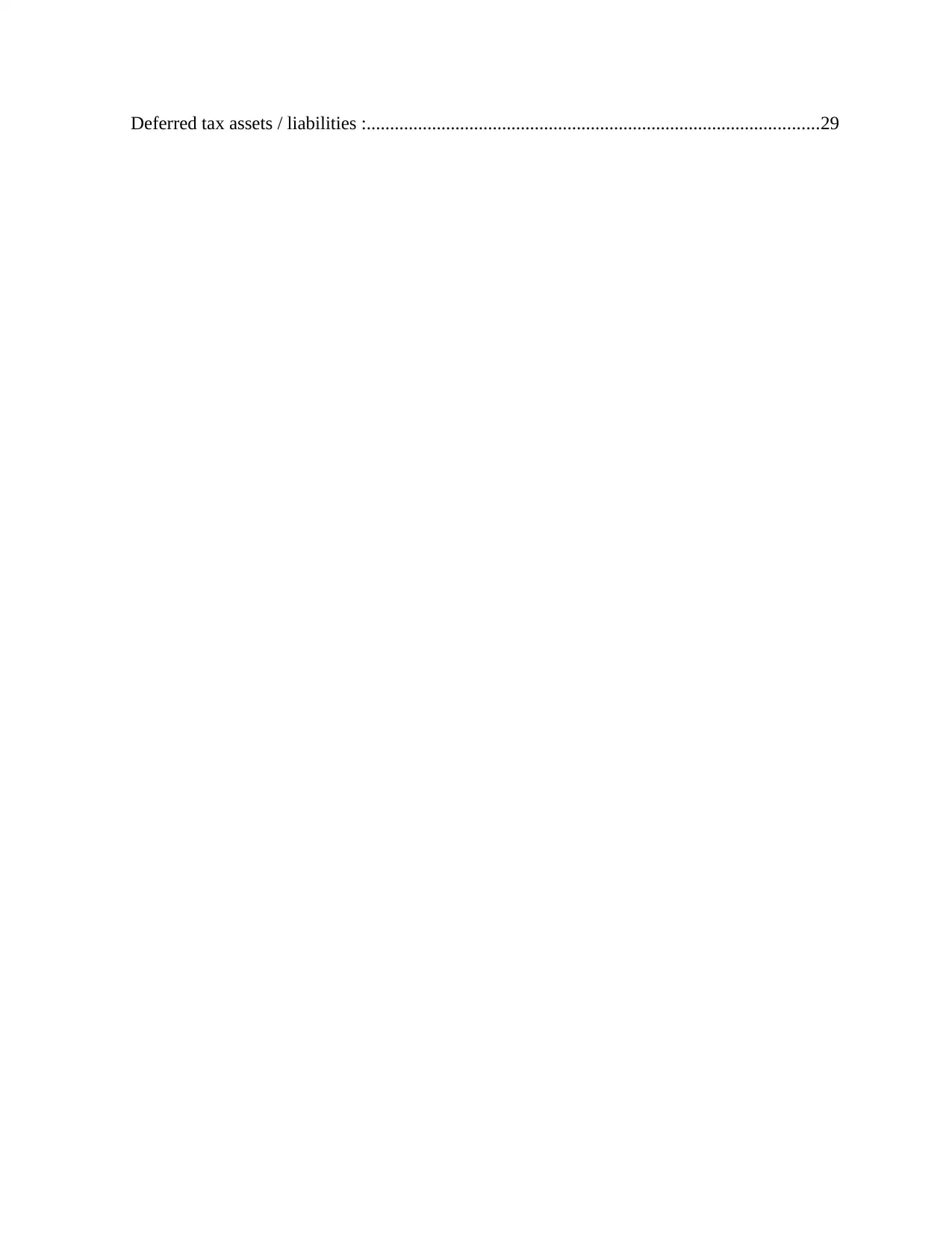
⊘ This is a preview!⊘
Do you want full access?
Subscribe today to unlock all pages.

Trusted by 1+ million students worldwide
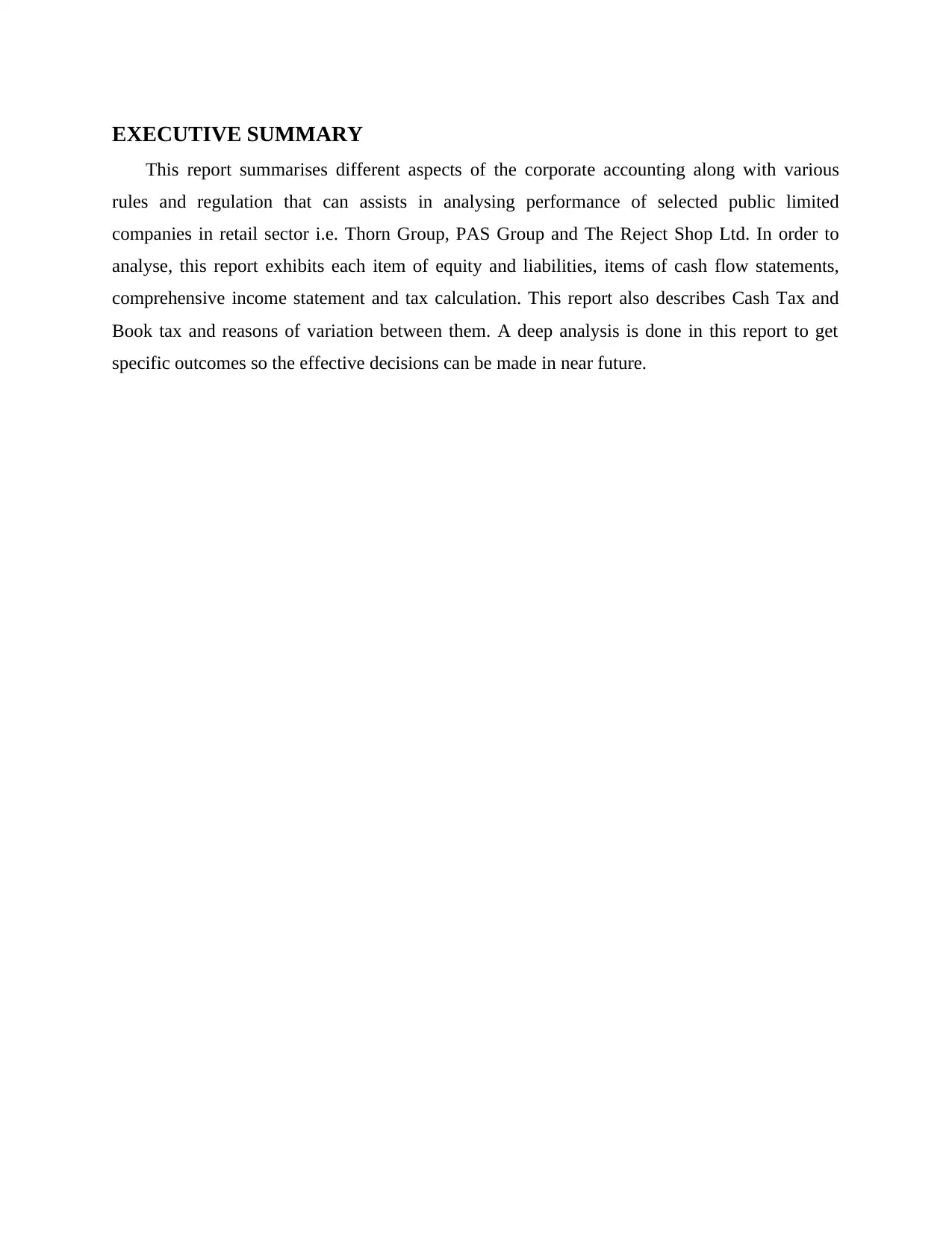
This report summarises different aspects of the corporate accounting along with various
rules and regulation that can assists in analysing performance of selected public limited
companies in retail sector i.e. Thorn Group, PAS Group and The Reject Shop Ltd. In order to
analyse, this report exhibits each item of equity and liabilities, items of cash flow statements,
comprehensive income statement and tax calculation. This report also describes Cash Tax and
Book tax and reasons of variation between them. A deep analysis is done in this report to get
specific outcomes so the effective decisions can be made in near future.
Paraphrase This Document
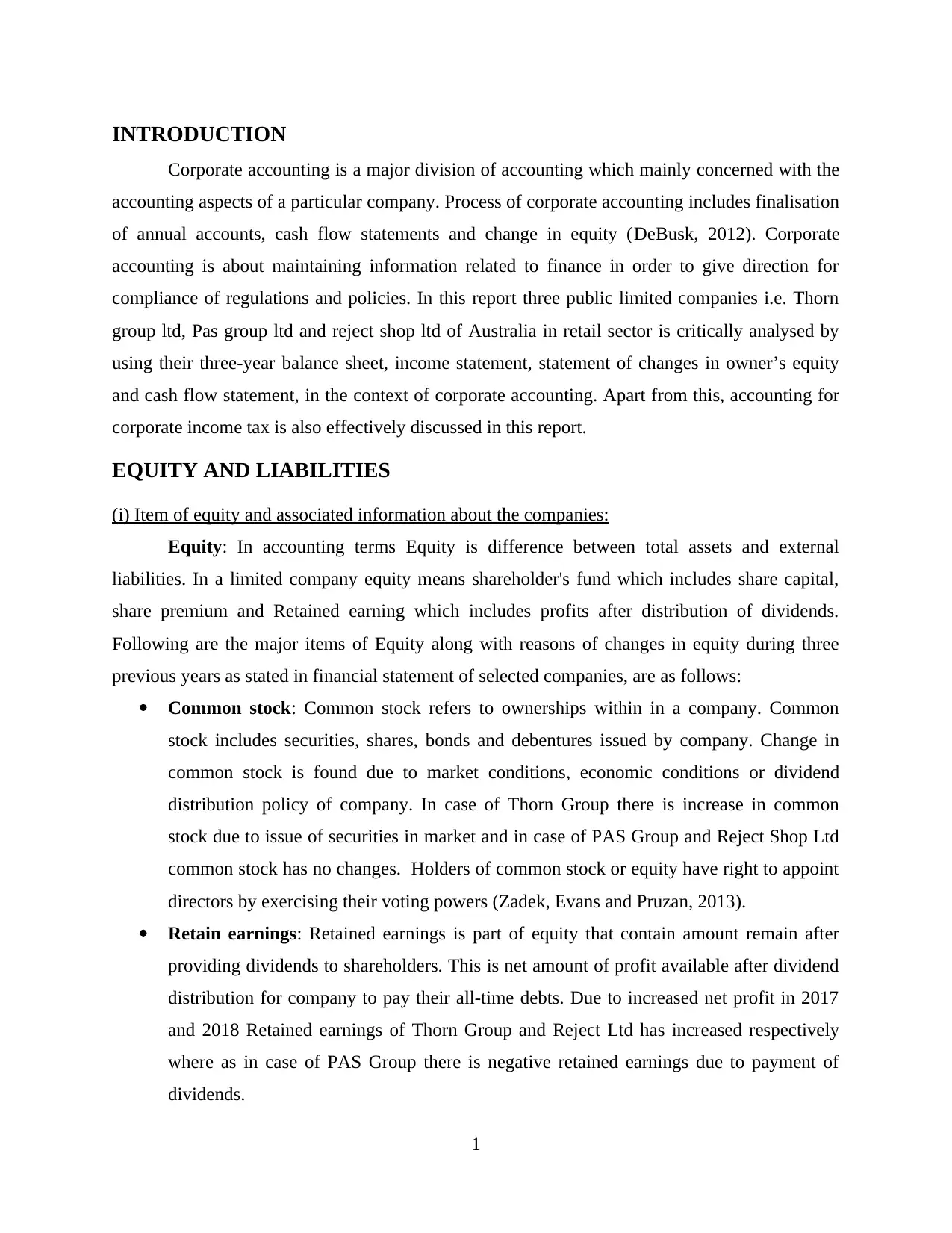
Corporate accounting is a major division of accounting which mainly concerned with the
accounting aspects of a particular company. Process of corporate accounting includes finalisation
of annual accounts, cash flow statements and change in equity (DeBusk, 2012). Corporate
accounting is about maintaining information related to finance in order to give direction for
compliance of regulations and policies. In this report three public limited companies i.e. Thorn
group ltd, Pas group ltd and reject shop ltd of Australia in retail sector is critically analysed by
using their three-year balance sheet, income statement, statement of changes in owner’s equity
and cash flow statement, in the context of corporate accounting. Apart from this, accounting for
corporate income tax is also effectively discussed in this report.
EQUITY AND LIABILITIES
(i) Item of equity and associated information about the companies:
Equity: In accounting terms Equity is difference between total assets and external
liabilities. In a limited company equity means shareholder's fund which includes share capital,
share premium and Retained earning which includes profits after distribution of dividends.
Following are the major items of Equity along with reasons of changes in equity during three
previous years as stated in financial statement of selected companies, are as follows:
Common stock: Common stock refers to ownerships within in a company. Common
stock includes securities, shares, bonds and debentures issued by company. Change in
common stock is found due to market conditions, economic conditions or dividend
distribution policy of company. In case of Thorn Group there is increase in common
stock due to issue of securities in market and in case of PAS Group and Reject Shop Ltd
common stock has no changes. Holders of common stock or equity have right to appoint
directors by exercising their voting powers (Zadek, Evans and Pruzan, 2013).
Retain earnings: Retained earnings is part of equity that contain amount remain after
providing dividends to shareholders. This is net amount of profit available after dividend
distribution for company to pay their all-time debts. Due to increased net profit in 2017
and 2018 Retained earnings of Thorn Group and Reject Ltd has increased respectively
where as in case of PAS Group there is negative retained earnings due to payment of
dividends.
1
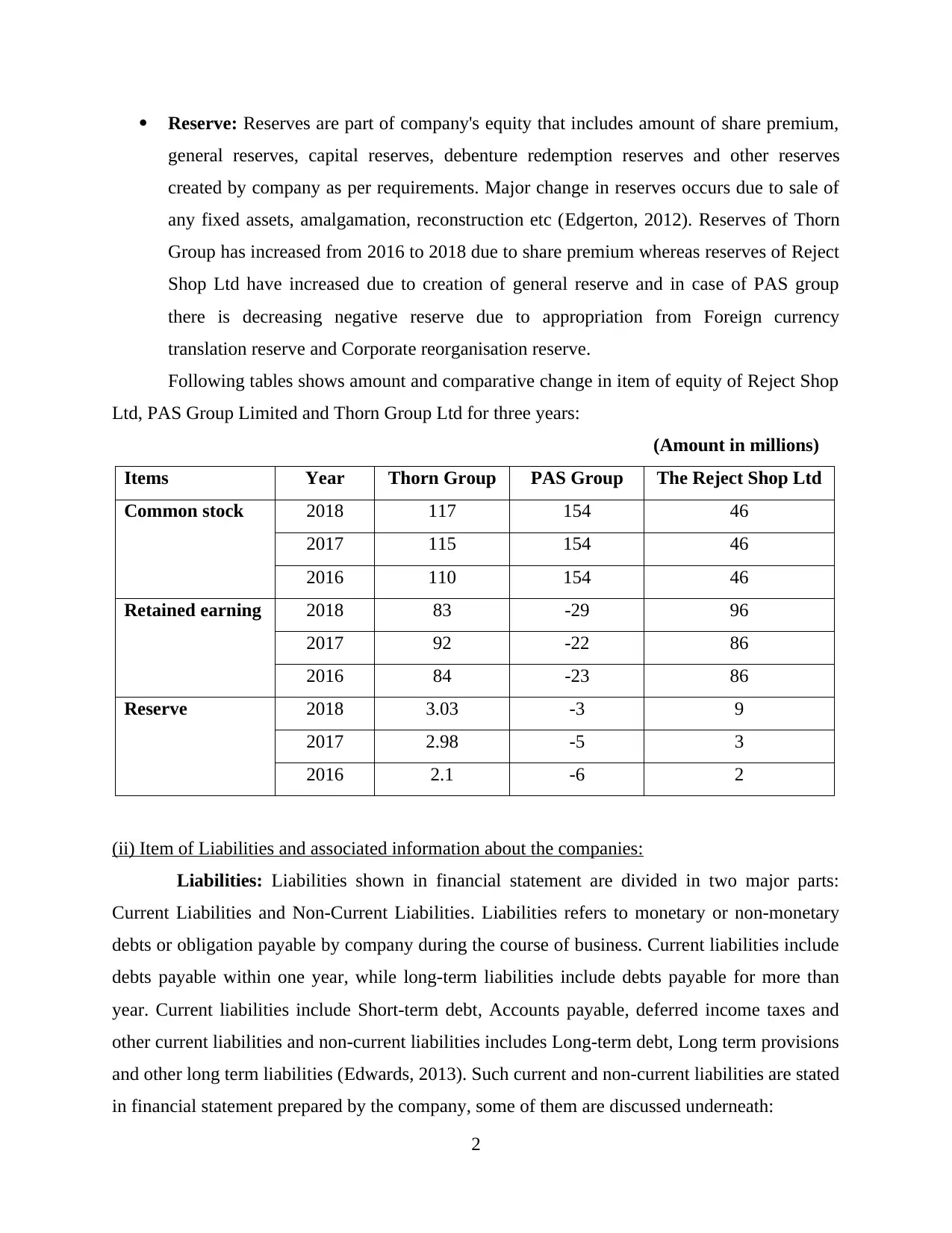
general reserves, capital reserves, debenture redemption reserves and other reserves
created by company as per requirements. Major change in reserves occurs due to sale of
any fixed assets, amalgamation, reconstruction etc (Edgerton, 2012). Reserves of Thorn
Group has increased from 2016 to 2018 due to share premium whereas reserves of Reject
Shop Ltd have increased due to creation of general reserve and in case of PAS group
there is decreasing negative reserve due to appropriation from Foreign currency
translation reserve and Corporate reorganisation reserve.
Following tables shows amount and comparative change in item of equity of Reject Shop
Ltd, PAS Group Limited and Thorn Group Ltd for three years:
(Amount in millions)
Items Year Thorn Group PAS Group The Reject Shop Ltd
Common stock 2018 117 154 46
2017 115 154 46
2016 110 154 46
Retained earning 2018 83 -29 96
2017 92 -22 86
2016 84 -23 86
Reserve 2018 3.03 -3 9
2017 2.98 -5 3
2016 2.1 -6 2
(ii) Item of Liabilities and associated information about the companies:
Liabilities: Liabilities shown in financial statement are divided in two major parts:
Current Liabilities and Non-Current Liabilities. Liabilities refers to monetary or non-monetary
debts or obligation payable by company during the course of business. Current liabilities include
debts payable within one year, while long-term liabilities include debts payable for more than
year. Current liabilities include Short-term debt, Accounts payable, deferred income taxes and
other current liabilities and non-current liabilities includes Long-term debt, Long term provisions
and other long term liabilities (Edwards, 2013). Such current and non-current liabilities are stated
in financial statement prepared by the company, some of them are discussed underneath:
2
⊘ This is a preview!⊘
Do you want full access?
Subscribe today to unlock all pages.

Trusted by 1+ million students worldwide
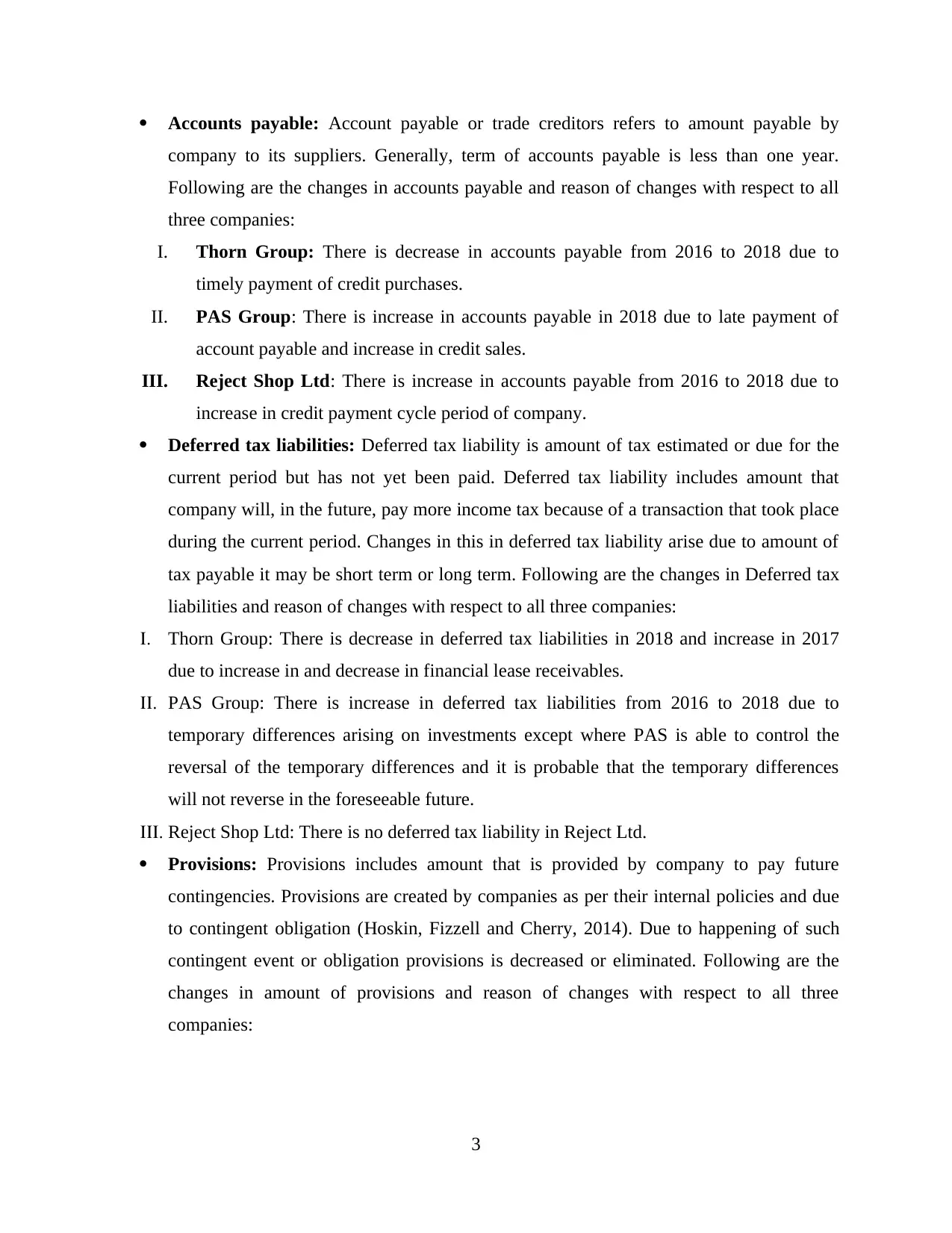
company to its suppliers. Generally, term of accounts payable is less than one year.
Following are the changes in accounts payable and reason of changes with respect to all
three companies:
I. Thorn Group: There is decrease in accounts payable from 2016 to 2018 due to
timely payment of credit purchases.
II. PAS Group: There is increase in accounts payable in 2018 due to late payment of
account payable and increase in credit sales.
III. Reject Shop Ltd: There is increase in accounts payable from 2016 to 2018 due to
increase in credit payment cycle period of company.
Deferred tax liabilities: Deferred tax liability is amount of tax estimated or due for the
current period but has not yet been paid. Deferred tax liability includes amount that
company will, in the future, pay more income tax because of a transaction that took place
during the current period. Changes in this in deferred tax liability arise due to amount of
tax payable it may be short term or long term. Following are the changes in Deferred tax
liabilities and reason of changes with respect to all three companies:
I. Thorn Group: There is decrease in deferred tax liabilities in 2018 and increase in 2017
due to increase in and decrease in financial lease receivables.
II. PAS Group: There is increase in deferred tax liabilities from 2016 to 2018 due to
temporary differences arising on investments except where PAS is able to control the
reversal of the temporary differences and it is probable that the temporary differences
will not reverse in the foreseeable future.
III. Reject Shop Ltd: There is no deferred tax liability in Reject Ltd.
Provisions: Provisions includes amount that is provided by company to pay future
contingencies. Provisions are created by companies as per their internal policies and due
to contingent obligation (Hoskin, Fizzell and Cherry, 2014). Due to happening of such
contingent event or obligation provisions is decreased or eliminated. Following are the
changes in amount of provisions and reason of changes with respect to all three
companies:
3
Paraphrase This Document

to Provisions used or reversed during the year and Provisions made during the year
respectively.
II. PAS Group: There is no change in amount of provision made for probable employee
benefits payments.
III. Reject Shop Ltd: There is increase in amount of provision in 2018 due to creation of
provision for shrinking expenses, onerous lease contract.
Overdraft: Overdraft means withdrawal of amount from bank' current account even if
bank account shows zero or negative balance. Following are the changes in amount of
overdraft and reason of changes with respect to all three companies:
I. Thorn Group: There is increase in amount of overdraft in 2018 to meet the working
capital requirements.
II. PAS Group: there is overdraft facility availed by company from bank only in 2018 to pay
its day to day expenses.
III. Reject Shop Ltd: There is no overdraft in Reject Shop Ltd.
Long term borrowings or long term debt: It refers to amount borrowed for a period
exceeding 12 months from bank or other financial institution. Long term borrowings
include bank loan, mortgage bonds, debenture, or other obligations not due for one year.
Companies are required to disclose its long-term debt in its financial statements along
with interest rate and date of maturity. Increase in long term borrowings shows
dependences of company on debts instead of equity or inability to pay debts. Following
are the changes in amount of Long term borrowings and reason of changes with respect
to all three companies:
Thorn Group: There is increase in amount of overdraft in 2018 to meet the working
capital requirements.
PAS Group: There is increase in amount of long term borrowings in 2018 to borrowing
taken for payment of lease incentives remain due.
Reject Shop Ltd: There is increase in amount of long term borrowings from 2016 to 2018
due to increase in borrowing taken for payment of rent escalation.
Following tables assists in interpreting data of Reject Shop Ltd, PAS Group Limited and
Thorn Group Ltd for three years:
4
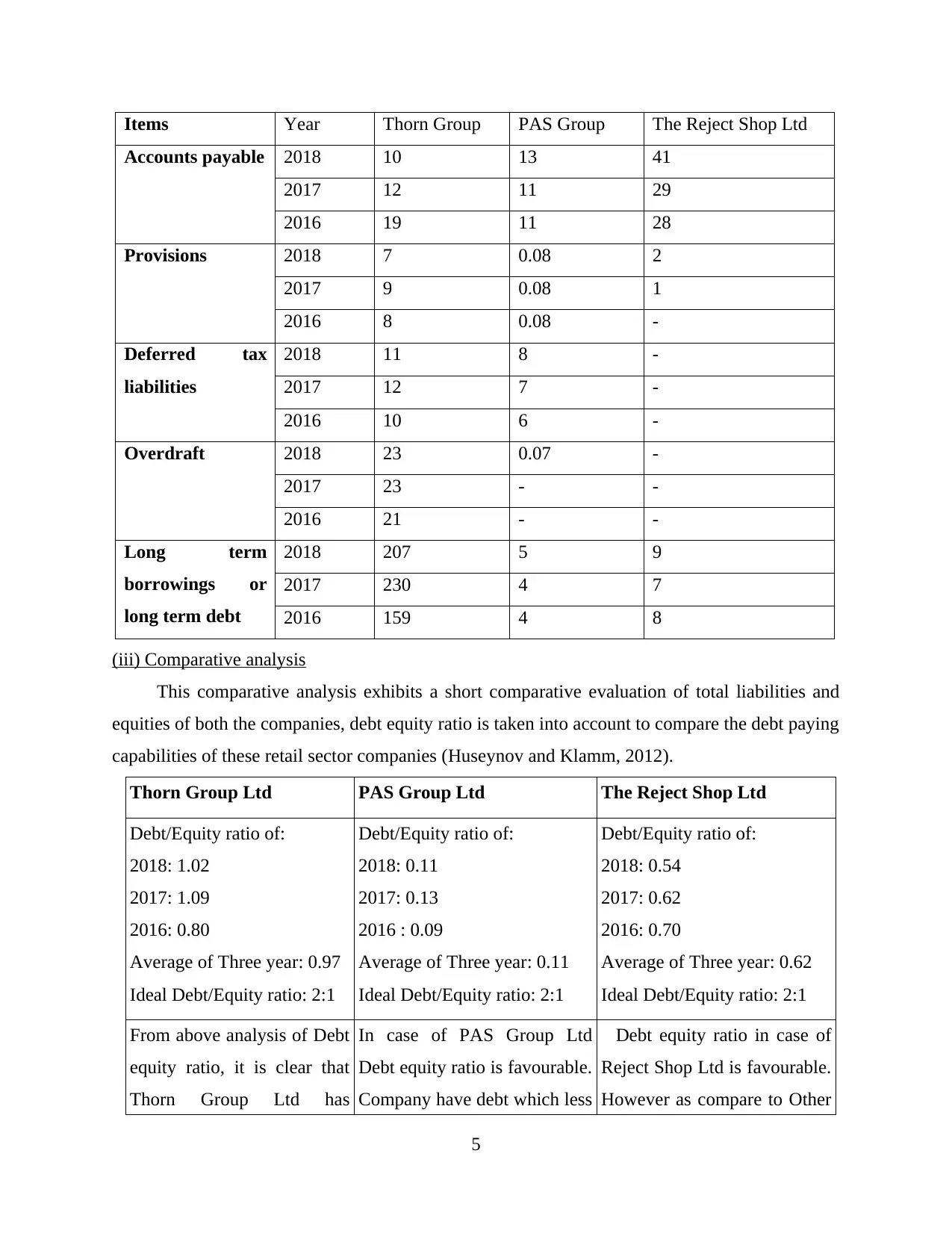
Accounts payable 2018 10 13 41
2017 12 11 29
2016 19 11 28
Provisions 2018 7 0.08 2
2017 9 0.08 1
2016 8 0.08 -
Deferred tax
liabilities
2018 11 8 -
2017 12 7 -
2016 10 6 -
Overdraft 2018 23 0.07 -
2017 23 - -
2016 21 - -
Long term
borrowings or
long term debt
2018 207 5 9
2017 230 4 7
2016 159 4 8
(iii) Comparative analysis
This comparative analysis exhibits a short comparative evaluation of total liabilities and
equities of both the companies, debt equity ratio is taken into account to compare the debt paying
capabilities of these retail sector companies (Huseynov and Klamm, 2012).
Thorn Group Ltd PAS Group Ltd The Reject Shop Ltd
Debt/Equity ratio of:
2018: 1.02
2017: 1.09
2016: 0.80
Average of Three year: 0.97
Ideal Debt/Equity ratio: 2:1
Debt/Equity ratio of:
2018: 0.11
2017: 0.13
2016 : 0.09
Average of Three year: 0.11
Ideal Debt/Equity ratio: 2:1
Debt/Equity ratio of:
2018: 0.54
2017: 0.62
2016: 0.70
Average of Three year: 0.62
Ideal Debt/Equity ratio: 2:1
From above analysis of Debt
equity ratio, it is clear that
Thorn Group Ltd has
In case of PAS Group Ltd
Debt equity ratio is favourable.
Company have debt which less
Debt equity ratio in case of
Reject Shop Ltd is favourable.
However as compare to Other
5
⊘ This is a preview!⊘
Do you want full access?
Subscribe today to unlock all pages.

Trusted by 1+ million students worldwide
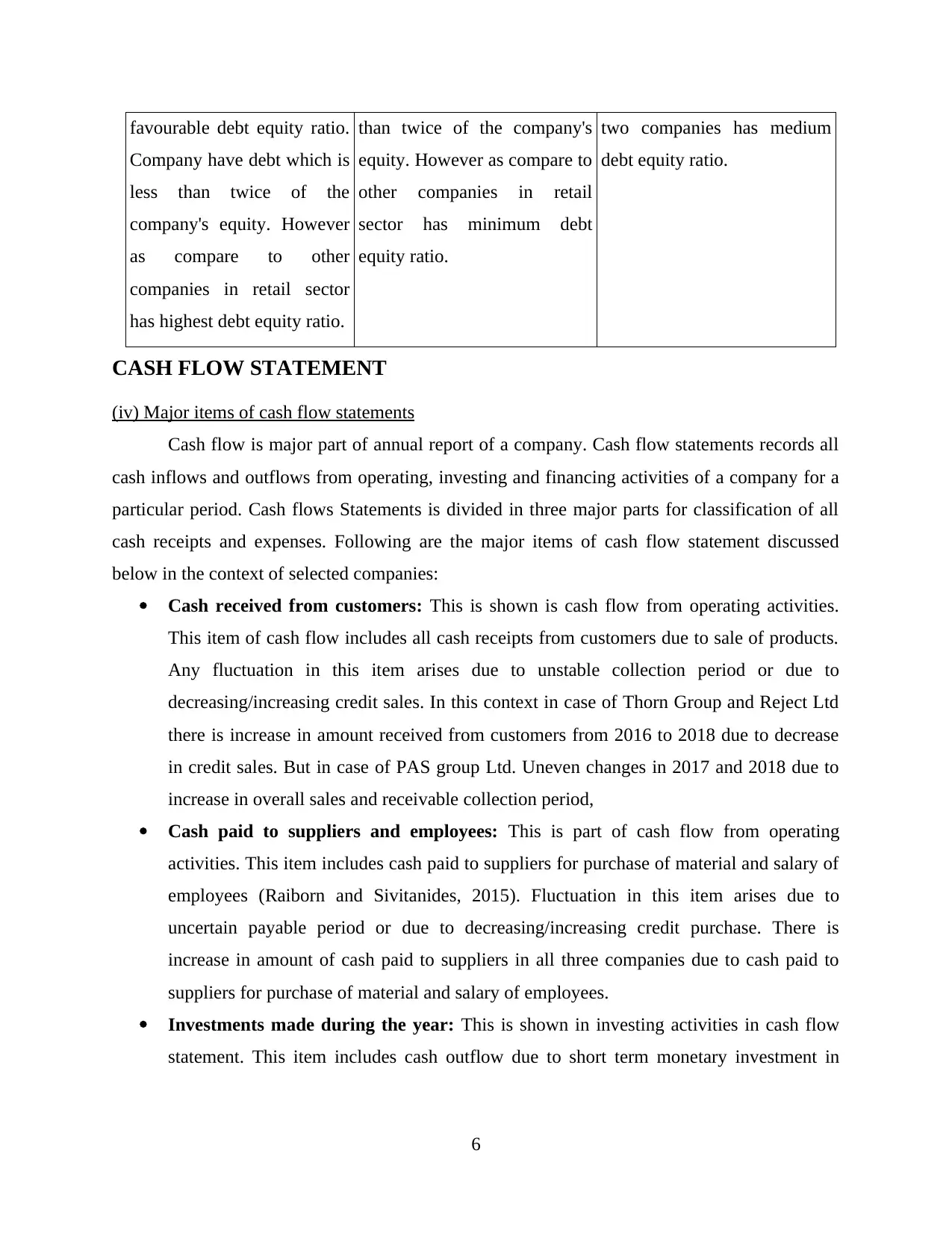
Company have debt which is
less than twice of the
company's equity. However
as compare to other
companies in retail sector
has highest debt equity ratio.
than twice of the company's
equity. However as compare to
other companies in retail
sector has minimum debt
equity ratio.
two companies has medium
debt equity ratio.
CASH FLOW STATEMENT
(iv) Major items of cash flow statements
Cash flow is major part of annual report of a company. Cash flow statements records all
cash inflows and outflows from operating, investing and financing activities of a company for a
particular period. Cash flows Statements is divided in three major parts for classification of all
cash receipts and expenses. Following are the major items of cash flow statement discussed
below in the context of selected companies:
Cash received from customers: This is shown is cash flow from operating activities.
This item of cash flow includes all cash receipts from customers due to sale of products.
Any fluctuation in this item arises due to unstable collection period or due to
decreasing/increasing credit sales. In this context in case of Thorn Group and Reject Ltd
there is increase in amount received from customers from 2016 to 2018 due to decrease
in credit sales. But in case of PAS group Ltd. Uneven changes in 2017 and 2018 due to
increase in overall sales and receivable collection period,
Cash paid to suppliers and employees: This is part of cash flow from operating
activities. This item includes cash paid to suppliers for purchase of material and salary of
employees (Raiborn and Sivitanides, 2015). Fluctuation in this item arises due to
uncertain payable period or due to decreasing/increasing credit purchase. There is
increase in amount of cash paid to suppliers in all three companies due to cash paid to
suppliers for purchase of material and salary of employees.
Investments made during the year: This is shown in investing activities in cash flow
statement. This item includes cash outflow due to short term monetary investment in
6
Paraphrase This Document
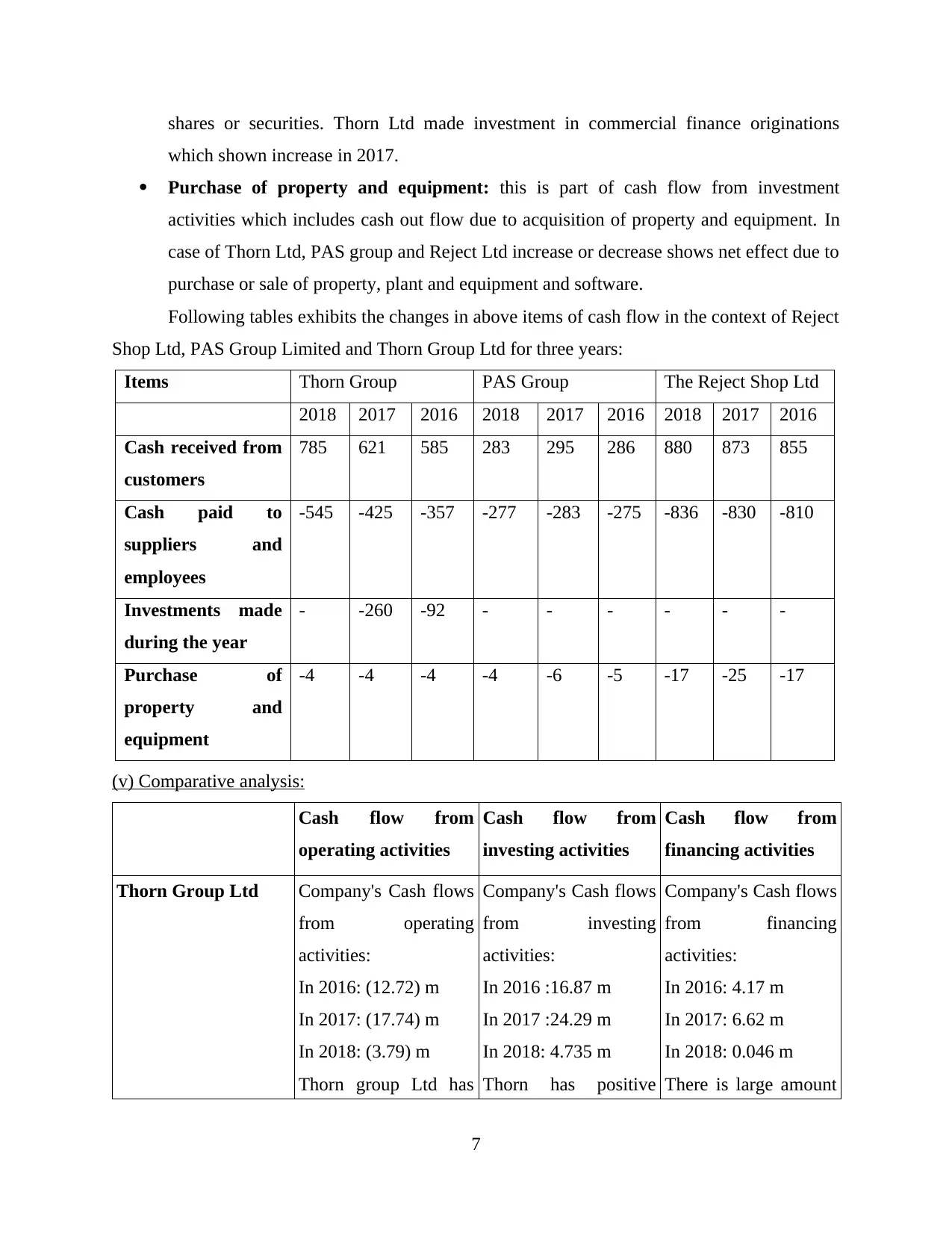
which shown increase in 2017.
Purchase of property and equipment: this is part of cash flow from investment
activities which includes cash out flow due to acquisition of property and equipment. In
case of Thorn Ltd, PAS group and Reject Ltd increase or decrease shows net effect due to
purchase or sale of property, plant and equipment and software.
Following tables exhibits the changes in above items of cash flow in the context of Reject
Shop Ltd, PAS Group Limited and Thorn Group Ltd for three years:
Items Thorn Group PAS Group The Reject Shop Ltd
2018 2017 2016 2018 2017 2016 2018 2017 2016
Cash received from
customers
785 621 585 283 295 286 880 873 855
Cash paid to
suppliers and
employees
-545 -425 -357 -277 -283 -275 -836 -830 -810
Investments made
during the year
- -260 -92 - - - - - -
Purchase of
property and
equipment
-4 -4 -4 -4 -6 -5 -17 -25 -17
(v) Comparative analysis:
Cash flow from
operating activities
Cash flow from
investing activities
Cash flow from
financing activities
Thorn Group Ltd Company's Cash flows
from operating
activities:
In 2016: (12.72) m
In 2017: (17.74) m
In 2018: (3.79) m
Thorn group Ltd has
Company's Cash flows
from investing
activities:
In 2016 :16.87 m
In 2017 :24.29 m
In 2018: 4.735 m
Thorn has positive
Company's Cash flows
from financing
activities:
In 2016: 4.17 m
In 2017: 6.62 m
In 2018: 0.046 m
There is large amount
7
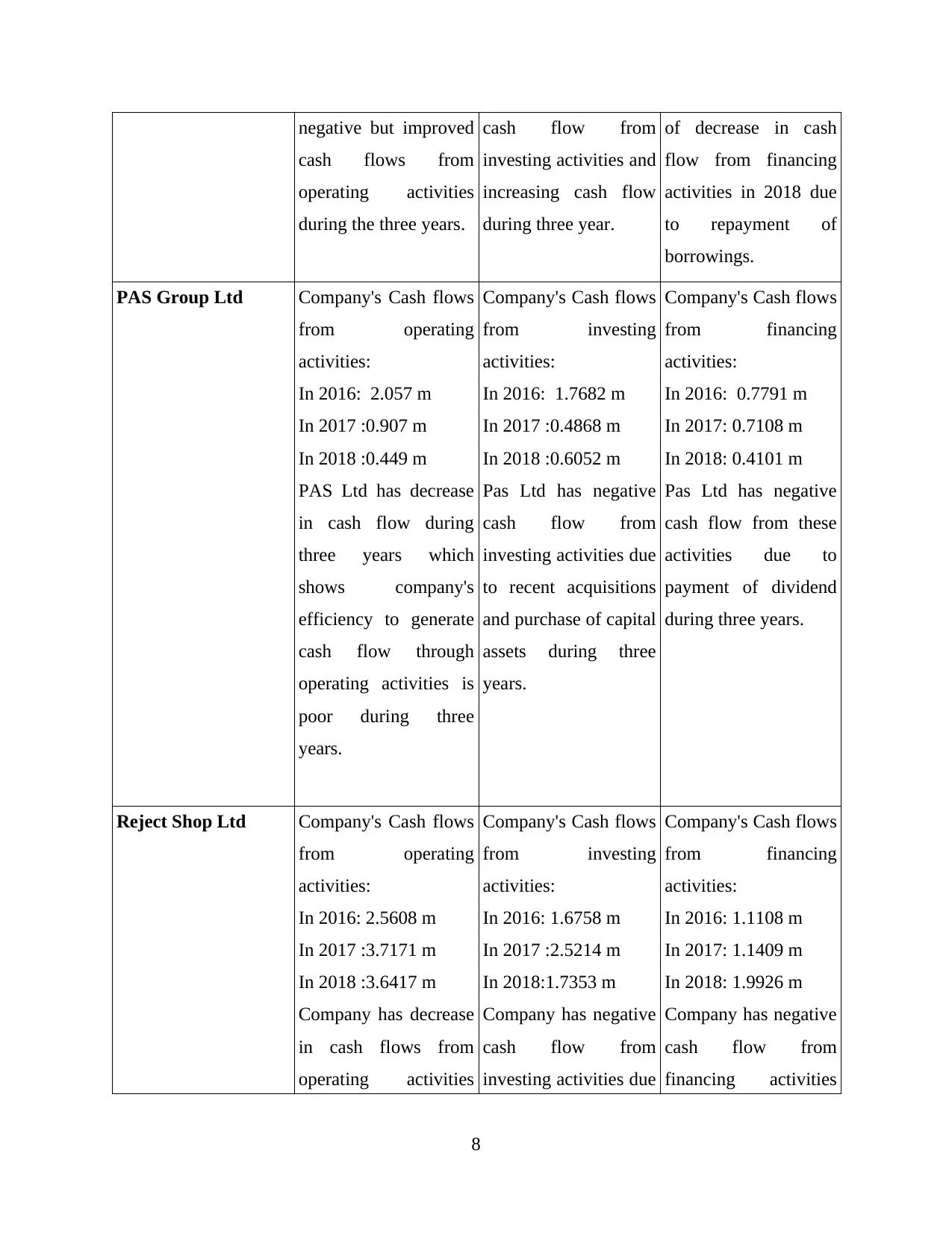
cash flows from
operating activities
during the three years.
cash flow from
investing activities and
increasing cash flow
during three year.
of decrease in cash
flow from financing
activities in 2018 due
to repayment of
borrowings.
PAS Group Ltd Company's Cash flows
from operating
activities:
In 2016: 2.057 m
In 2017 :0.907 m
In 2018 :0.449 m
PAS Ltd has decrease
in cash flow during
three years which
shows company's
efficiency to generate
cash flow through
operating activities is
poor during three
years.
Company's Cash flows
from investing
activities:
In 2016: 1.7682 m
In 2017 :0.4868 m
In 2018 :0.6052 m
Pas Ltd has negative
cash flow from
investing activities due
to recent acquisitions
and purchase of capital
assets during three
years.
Company's Cash flows
from financing
activities:
In 2016: 0.7791 m
In 2017: 0.7108 m
In 2018: 0.4101 m
Pas Ltd has negative
cash flow from these
activities due to
payment of dividend
during three years.
Reject Shop Ltd Company's Cash flows
from operating
activities:
In 2016: 2.5608 m
In 2017 :3.7171 m
In 2018 :3.6417 m
Company has decrease
in cash flows from
operating activities
Company's Cash flows
from investing
activities:
In 2016: 1.6758 m
In 2017 :2.5214 m
In 2018:1.7353 m
Company has negative
cash flow from
investing activities due
Company's Cash flows
from financing
activities:
In 2016: 1.1108 m
In 2017: 1.1409 m
In 2018: 1.9926 m
Company has negative
cash flow from
financing activities
8
⊘ This is a preview!⊘
Do you want full access?
Subscribe today to unlock all pages.

Trusted by 1+ million students worldwide
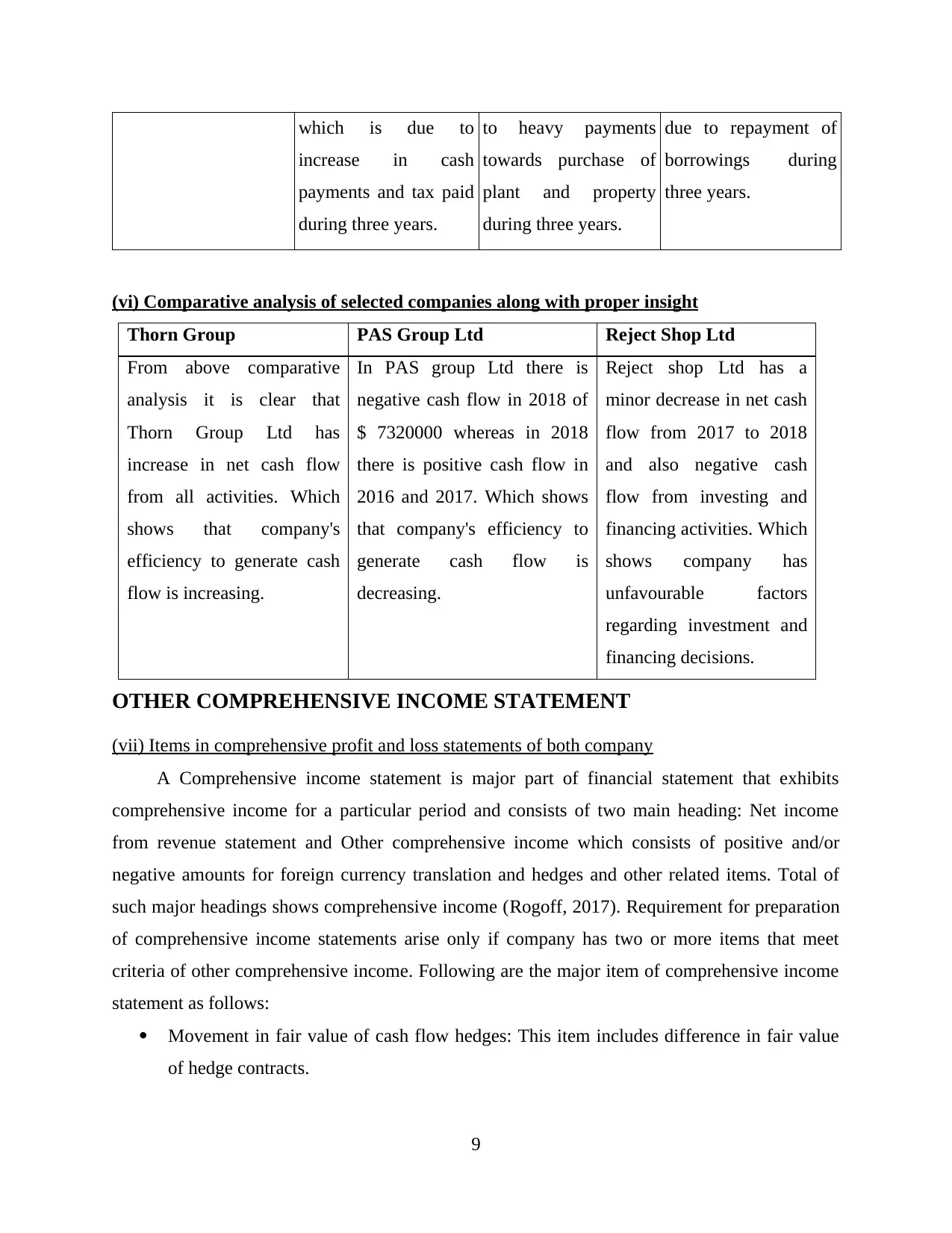
increase in cash
payments and tax paid
during three years.
to heavy payments
towards purchase of
plant and property
during three years.
due to repayment of
borrowings during
three years.
(vi) Comparative analysis of selected companies along with proper insight
Thorn Group PAS Group Ltd Reject Shop Ltd
From above comparative
analysis it is clear that
Thorn Group Ltd has
increase in net cash flow
from all activities. Which
shows that company's
efficiency to generate cash
flow is increasing.
In PAS group Ltd there is
negative cash flow in 2018 of
$ 7320000 whereas in 2018
there is positive cash flow in
2016 and 2017. Which shows
that company's efficiency to
generate cash flow is
decreasing.
Reject shop Ltd has a
minor decrease in net cash
flow from 2017 to 2018
and also negative cash
flow from investing and
financing activities. Which
shows company has
unfavourable factors
regarding investment and
financing decisions.
OTHER COMPREHENSIVE INCOME STATEMENT
(vii) Items in comprehensive profit and loss statements of both company
A Comprehensive income statement is major part of financial statement that exhibits
comprehensive income for a particular period and consists of two main heading: Net income
from revenue statement and Other comprehensive income which consists of positive and/or
negative amounts for foreign currency translation and hedges and other related items. Total of
such major headings shows comprehensive income (Rogoff, 2017). Requirement for preparation
of comprehensive income statements arise only if company has two or more items that meet
criteria of other comprehensive income. Following are the major item of comprehensive income
statement as follows:
Movement in fair value of cash flow hedges: This item includes difference in fair value
of hedge contracts.
9
Paraphrase This Document
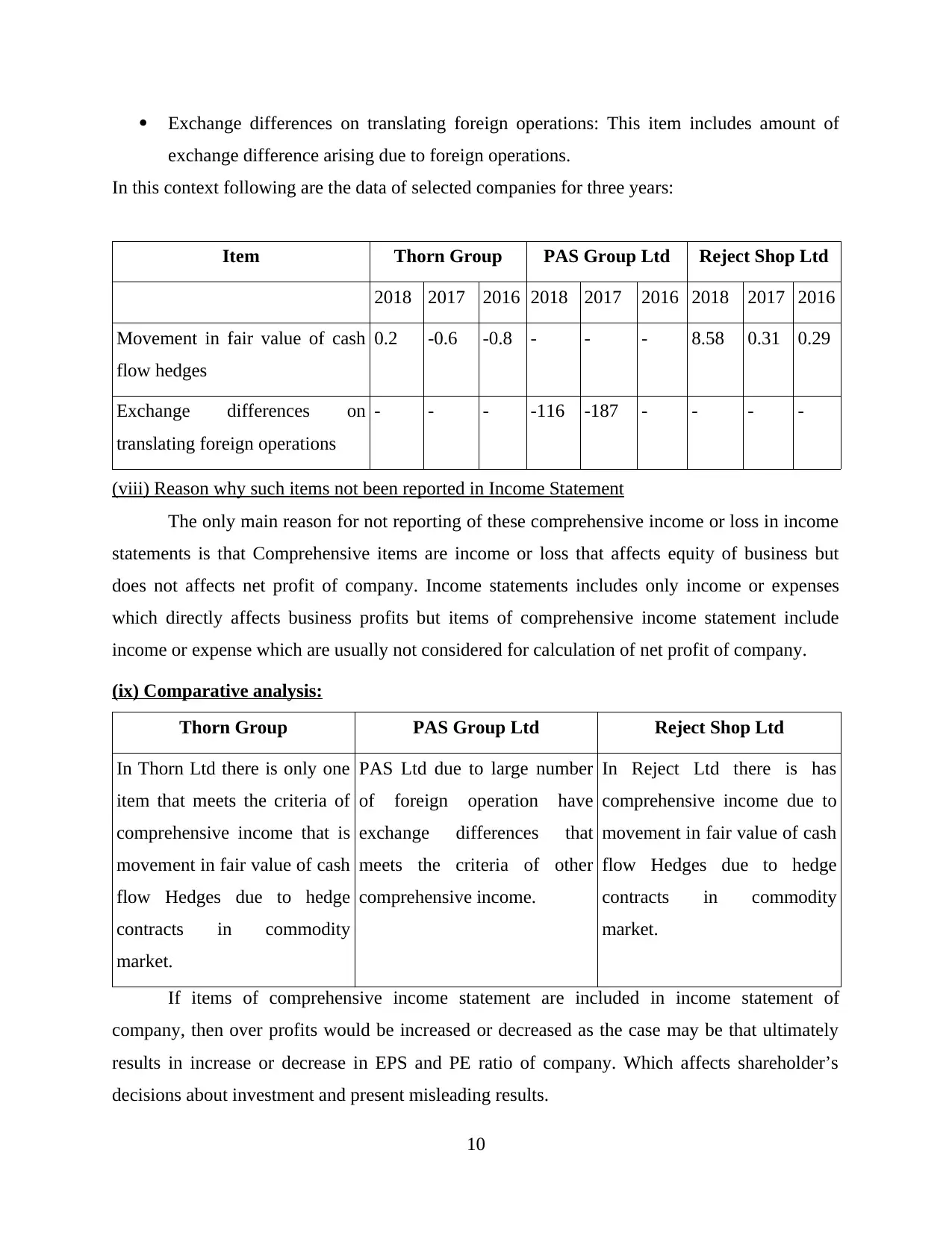
exchange difference arising due to foreign operations.
In this context following are the data of selected companies for three years:
Item Thorn Group PAS Group Ltd Reject Shop Ltd
2018 2017 2016 2018 2017 2016 2018 2017 2016
Movement in fair value of cash
flow hedges
0.2 -0.6 -0.8 - - - 8.58 0.31 0.29
Exchange differences on
translating foreign operations
- - - -116 -187 - - - -
(viii) Reason why such items not been reported in Income Statement
The only main reason for not reporting of these comprehensive income or loss in income
statements is that Comprehensive items are income or loss that affects equity of business but
does not affects net profit of company. Income statements includes only income or expenses
which directly affects business profits but items of comprehensive income statement include
income or expense which are usually not considered for calculation of net profit of company.
(ix) Comparative analysis:
Thorn Group PAS Group Ltd Reject Shop Ltd
In Thorn Ltd there is only one
item that meets the criteria of
comprehensive income that is
movement in fair value of cash
flow Hedges due to hedge
contracts in commodity
market.
PAS Ltd due to large number
of foreign operation have
exchange differences that
meets the criteria of other
comprehensive income.
In Reject Ltd there is has
comprehensive income due to
movement in fair value of cash
flow Hedges due to hedge
contracts in commodity
market.
If items of comprehensive income statement are included in income statement of
company, then over profits would be increased or decreased as the case may be that ultimately
results in increase or decrease in EPS and PE ratio of company. Which affects shareholder’s
decisions about investment and present misleading results.
10
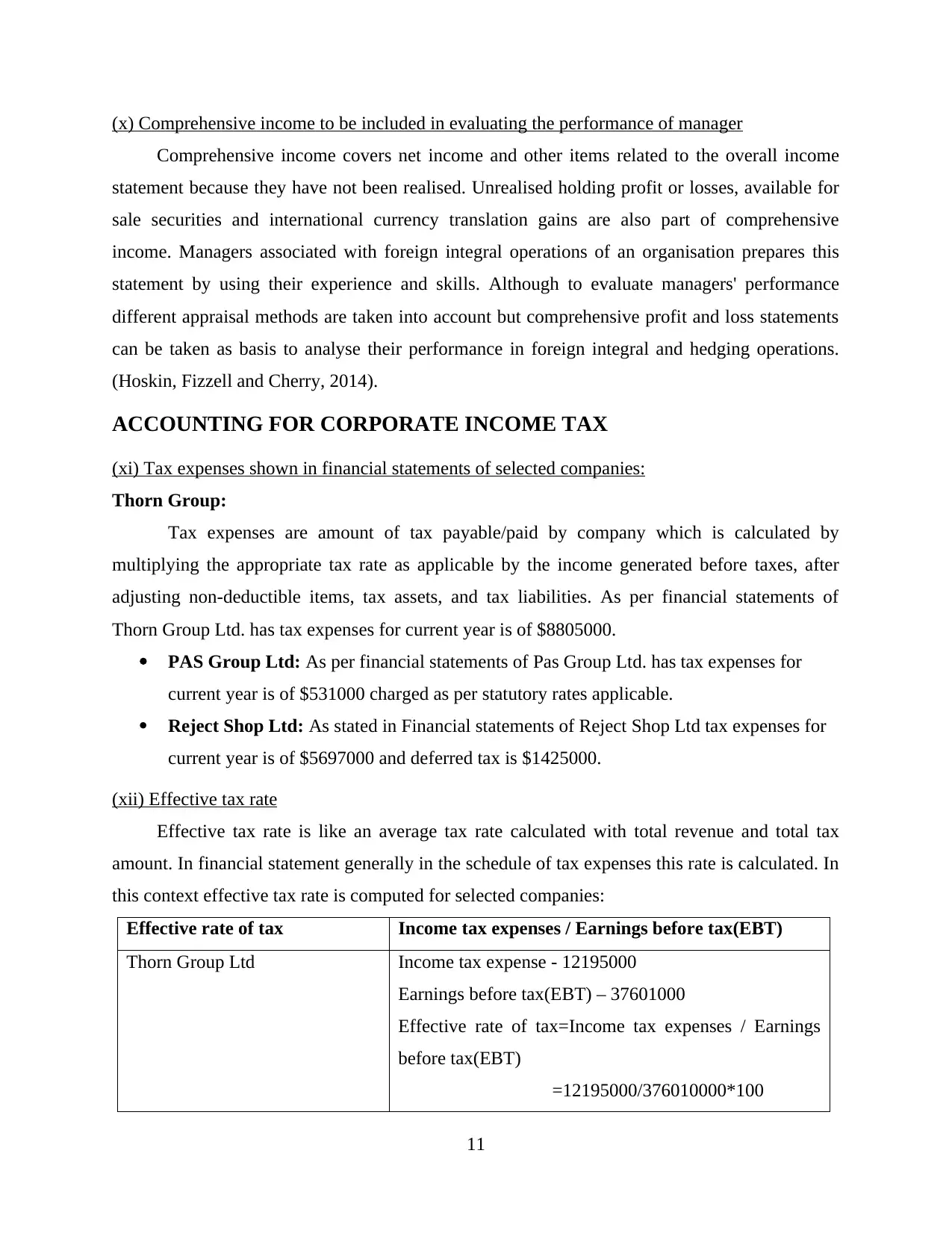
Comprehensive income covers net income and other items related to the overall income
statement because they have not been realised. Unrealised holding profit or losses, available for
sale securities and international currency translation gains are also part of comprehensive
income. Managers associated with foreign integral operations of an organisation prepares this
statement by using their experience and skills. Although to evaluate managers' performance
different appraisal methods are taken into account but comprehensive profit and loss statements
can be taken as basis to analyse their performance in foreign integral and hedging operations.
(Hoskin, Fizzell and Cherry, 2014).
ACCOUNTING FOR CORPORATE INCOME TAX
(xi) Tax expenses shown in financial statements of selected companies:
Thorn Group:
Tax expenses are amount of tax payable/paid by company which is calculated by
multiplying the appropriate tax rate as applicable by the income generated before taxes, after
adjusting non-deductible items, tax assets, and tax liabilities. As per financial statements of
Thorn Group Ltd. has tax expenses for current year is of $8805000.
PAS Group Ltd: As per financial statements of Pas Group Ltd. has tax expenses for
current year is of $531000 charged as per statutory rates applicable.
Reject Shop Ltd: As stated in Financial statements of Reject Shop Ltd tax expenses for
current year is of $5697000 and deferred tax is $1425000.
(xii) Effective tax rate
Effective tax rate is like an average tax rate calculated with total revenue and total tax
amount. In financial statement generally in the schedule of tax expenses this rate is calculated. In
this context effective tax rate is computed for selected companies:
Effective rate of tax Income tax expenses / Earnings before tax(EBT)
Thorn Group Ltd Income tax expense - 12195000
Earnings before tax(EBT) – 37601000
Effective rate of tax=Income tax expenses / Earnings
before tax(EBT)
=12195000/376010000*100
11
⊘ This is a preview!⊘
Do you want full access?
Subscribe today to unlock all pages.

Trusted by 1+ million students worldwide
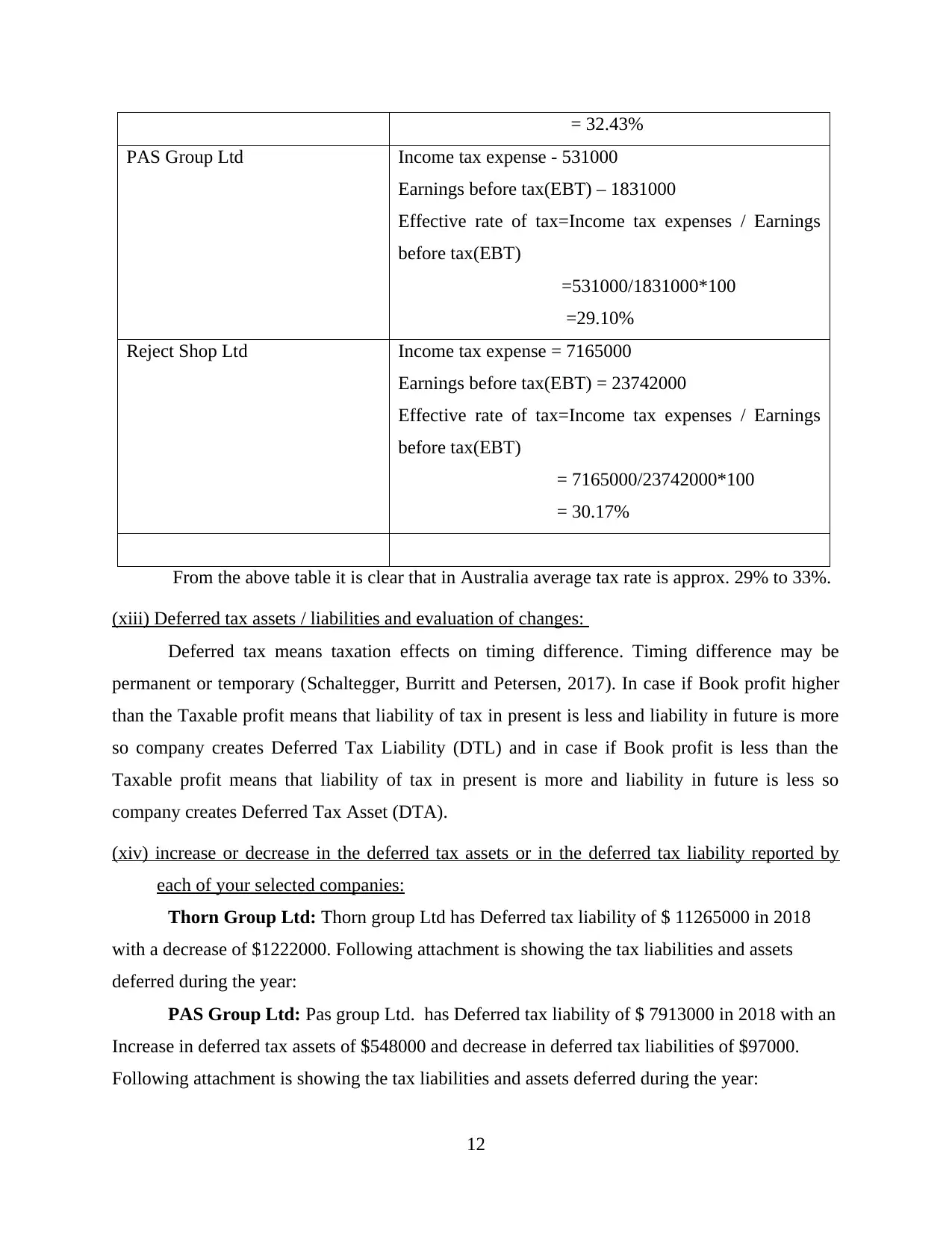
PAS Group Ltd Income tax expense - 531000
Earnings before tax(EBT) – 1831000
Effective rate of tax=Income tax expenses / Earnings
before tax(EBT)
=531000/1831000*100
=29.10%
Reject Shop Ltd Income tax expense = 7165000
Earnings before tax(EBT) = 23742000
Effective rate of tax=Income tax expenses / Earnings
before tax(EBT)
= 7165000/23742000*100
= 30.17%
From the above table it is clear that in Australia average tax rate is approx. 29% to 33%.
(xiii) Deferred tax assets / liabilities and evaluation of changes:
Deferred tax means taxation effects on timing difference. Timing difference may be
permanent or temporary (Schaltegger, Burritt and Petersen, 2017). In case if Book profit higher
than the Taxable profit means that liability of tax in present is less and liability in future is more
so company creates Deferred Tax Liability (DTL) and in case if Book profit is less than the
Taxable profit means that liability of tax in present is more and liability in future is less so
company creates Deferred Tax Asset (DTA).
(xiv) increase or decrease in the deferred tax assets or in the deferred tax liability reported by
each of your selected companies:
Thorn Group Ltd: Thorn group Ltd has Deferred tax liability of $ 11265000 in 2018
with a decrease of $1222000. Following attachment is showing the tax liabilities and assets
deferred during the year:
PAS Group Ltd: Pas group Ltd. has Deferred tax liability of $ 7913000 in 2018 with an
Increase in deferred tax assets of $548000 and decrease in deferred tax liabilities of $97000.
Following attachment is showing the tax liabilities and assets deferred during the year:
12
Paraphrase This Document
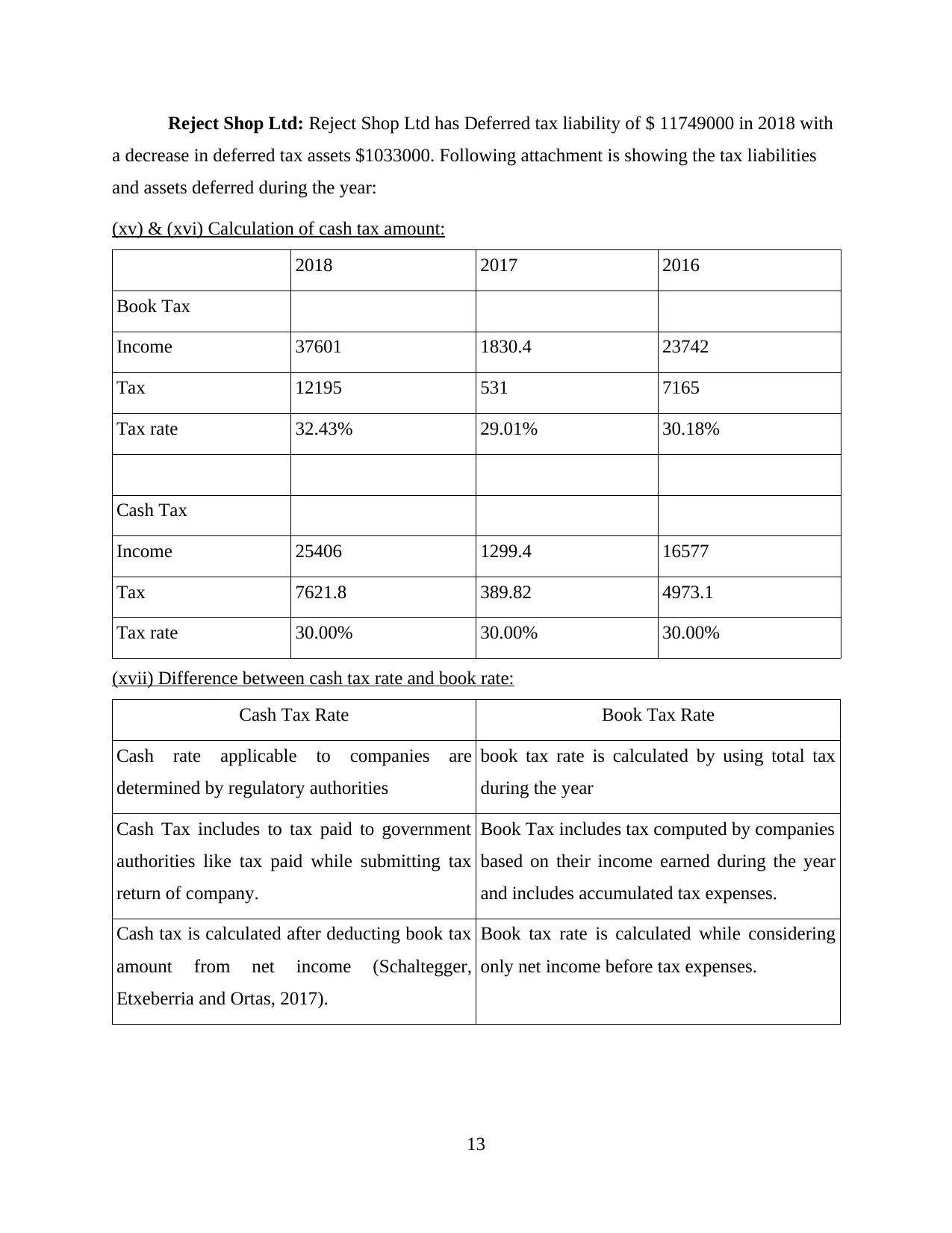
a decrease in deferred tax assets $1033000. Following attachment is showing the tax liabilities
and assets deferred during the year:
(xv) & (xvi) Calculation of cash tax amount:
2018 2017 2016
Book Tax
Income 37601 1830.4 23742
Tax 12195 531 7165
Tax rate 32.43% 29.01% 30.18%
Cash Tax
Income 25406 1299.4 16577
Tax 7621.8 389.82 4973.1
Tax rate 30.00% 30.00% 30.00%
(xvii) Difference between cash tax rate and book rate:
Cash Tax Rate Book Tax Rate
Cash rate applicable to companies are
determined by regulatory authorities
book tax rate is calculated by using total tax
during the year
Cash Tax includes to tax paid to government
authorities like tax paid while submitting tax
return of company.
Book Tax includes tax computed by companies
based on their income earned during the year
and includes accumulated tax expenses.
Cash tax is calculated after deducting book tax
amount from net income (Schaltegger,
Etxeberria and Ortas, 2017).
Book tax rate is calculated while considering
only net income before tax expenses.
13
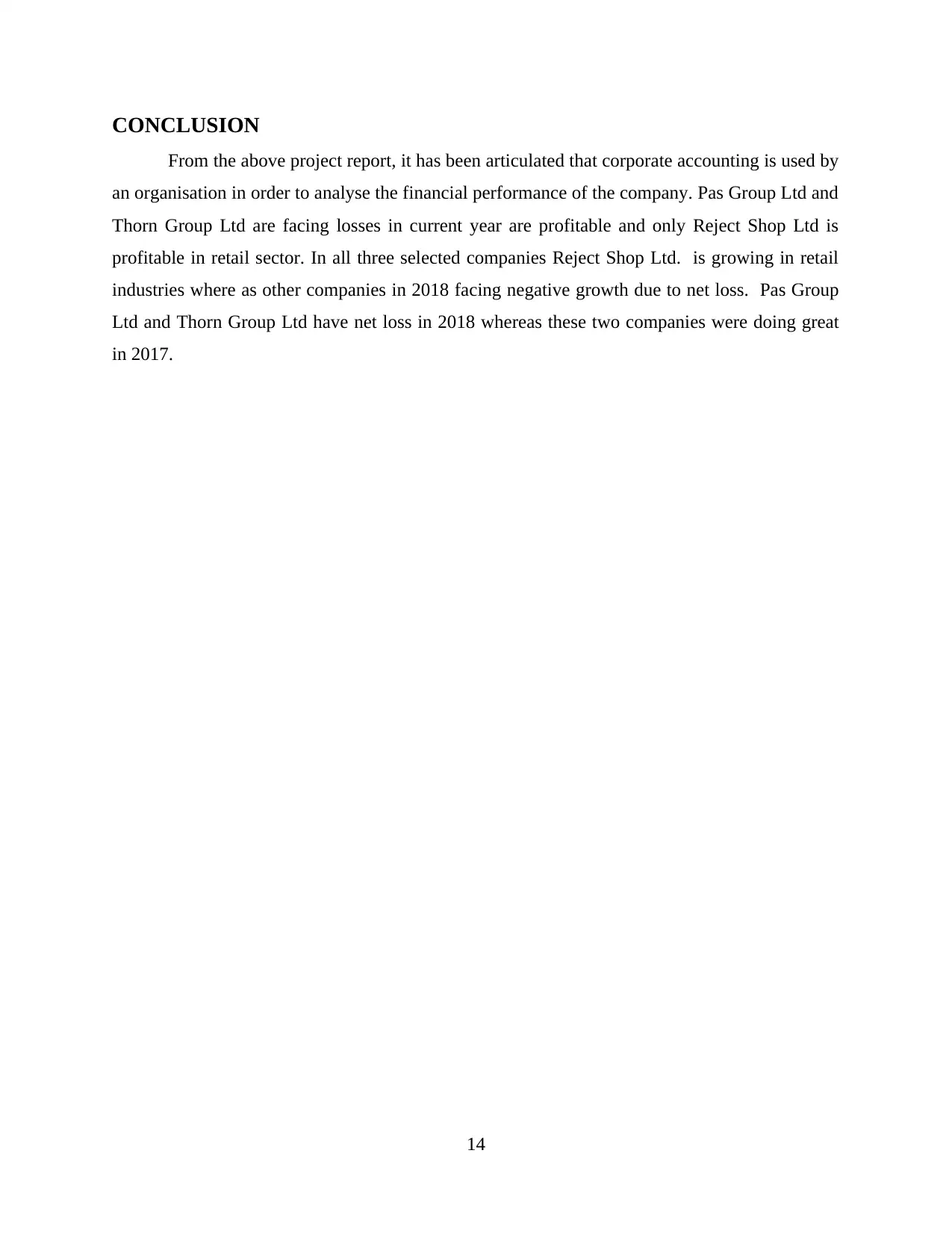
From the above project report, it has been articulated that corporate accounting is used by
an organisation in order to analyse the financial performance of the company. Pas Group Ltd and
Thorn Group Ltd are facing losses in current year are profitable and only Reject Shop Ltd is
profitable in retail sector. In all three selected companies Reject Shop Ltd. is growing in retail
industries where as other companies in 2018 facing negative growth due to net loss. Pas Group
Ltd and Thorn Group Ltd have net loss in 2018 whereas these two companies were doing great
in 2017.
14
⊘ This is a preview!⊘
Do you want full access?
Subscribe today to unlock all pages.

Trusted by 1+ million students worldwide

Books and Journal:
DeBusk, G. K., 2012. Use lean accounting to add value to the organization. Journal of Corporate
Accounting & Finance. 23(3). pp.35-41.
Edgerton, J., 2012. Investment, accounting, and the salience of the corporate income tax (No.
w18472). National Bureau of Economic Research.
Edwards, J. R., 2013. A History of Financial Accounting (RLE Accounting). Routledge.
Hoskin, R. E., Fizzell, M. R. and Cherry, D. C., 2014. Financial Accounting: a user perspective.
Wiley Global Education.
Huseynov, F. and Klamm, B.K., 2012. Tax avoidance, tax management and corporate social
responsibility. Journal of Corporate Finance. 18(4). pp.804-827.
Raiborn, C. and Sivitanides, M., 2015. Accounting issues related to Bitcoins. Journal of
Corporate Accounting & Finance. 26(2). pp.25-34.
Rogoff, K. S., 2017. The Curse of Cash: How Large-Denomination Bills Aid Crime and Tax
Evasion and Constrain Monetary Policy. Princeton University Press.
Schaltegger, S., Burritt, R. and Petersen, H., 2017. An introduction to corporate environmental
management: Striving for sustainability. Routledge.
Schaltegger, S., Etxeberria, I. Á. and Ortas, E., 2017. Innovating corporate accounting and
reporting for sustainability–attributes and challenges. Sustainable Development. 25(2).
pp.113-122.
Uyar, A., 2016. Evolution of corporate reporting and emerging trends. Journal of Corporate
Accounting & Finance. 27(4). pp.27-30.
Watson, L., 2015. Corporate social responsibility research in accounting. Journal of Accounting
Literature. 34. pp.1-16.
Zadek, S., Evans, R. and Pruzan, P., 2013. Building corporate accountability: Emerging practice
in social and ethical accounting and auditing. Routledge.
Online
Annual Report of Thron ltd. to Shareholders., 2018. [Online]. Annual report. Retrieve from
<http://www.thorn.com.au/irm/PDF/2476_0/AnnualReporttoShareholders2018>.
Annual Report of Reject Shop Ltd to Shareholders. 2018. [Online]. Annual report. Retrieve from
<https://www.rejectshop.com.au/medias/Appendix-4E-and-Annual-Report.pdf>.
Annual Report of the Pas Group Ltd to Shareholders. 2018. [Online]. Annual report. Retrieve
from < https://thepasgroup.com.au/wp-content/uploads/2018/09/20180921_PGR-Annual-
Report-to-Shareholders.pdf>
15
Paraphrase This Document
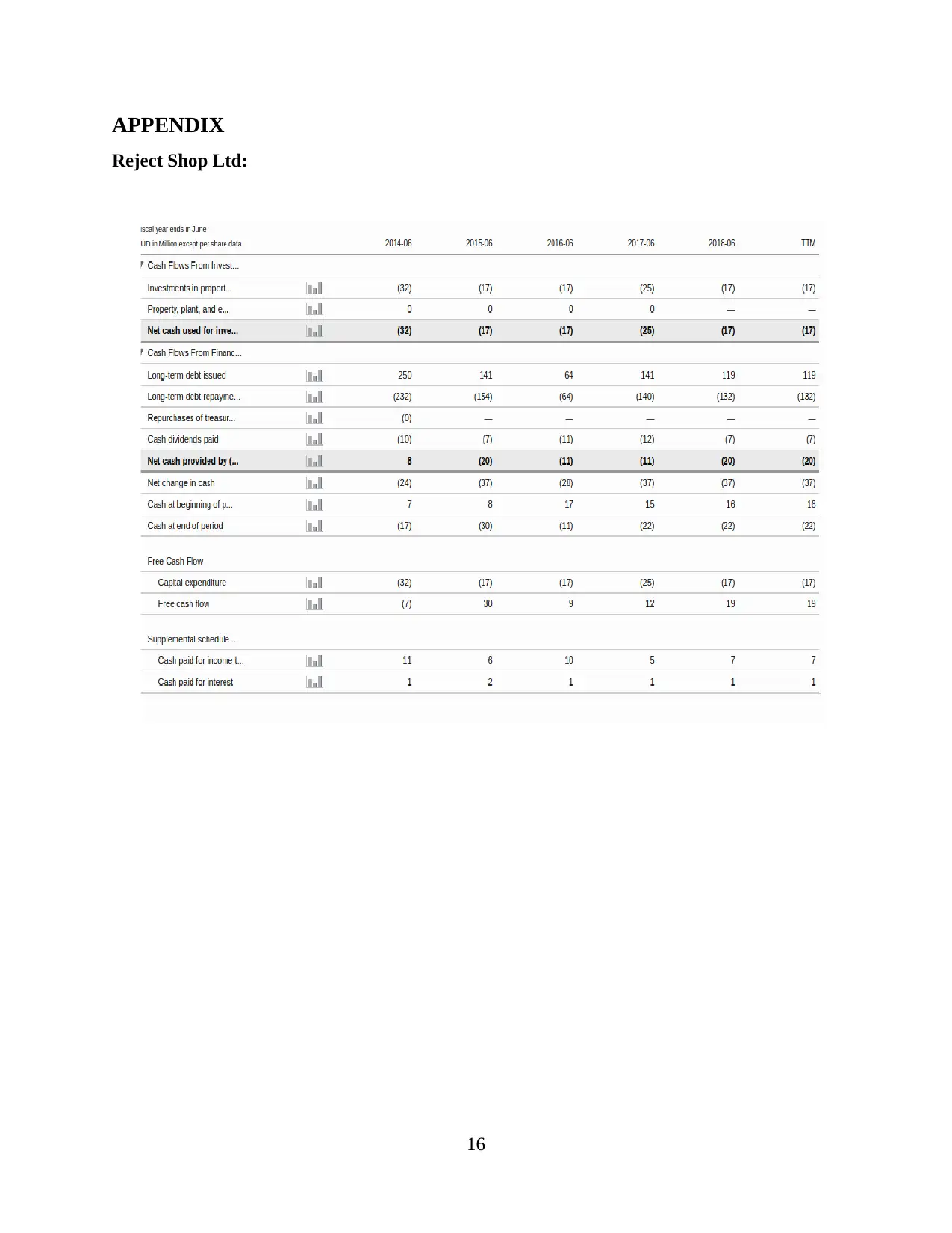
Reject Shop Ltd:
16
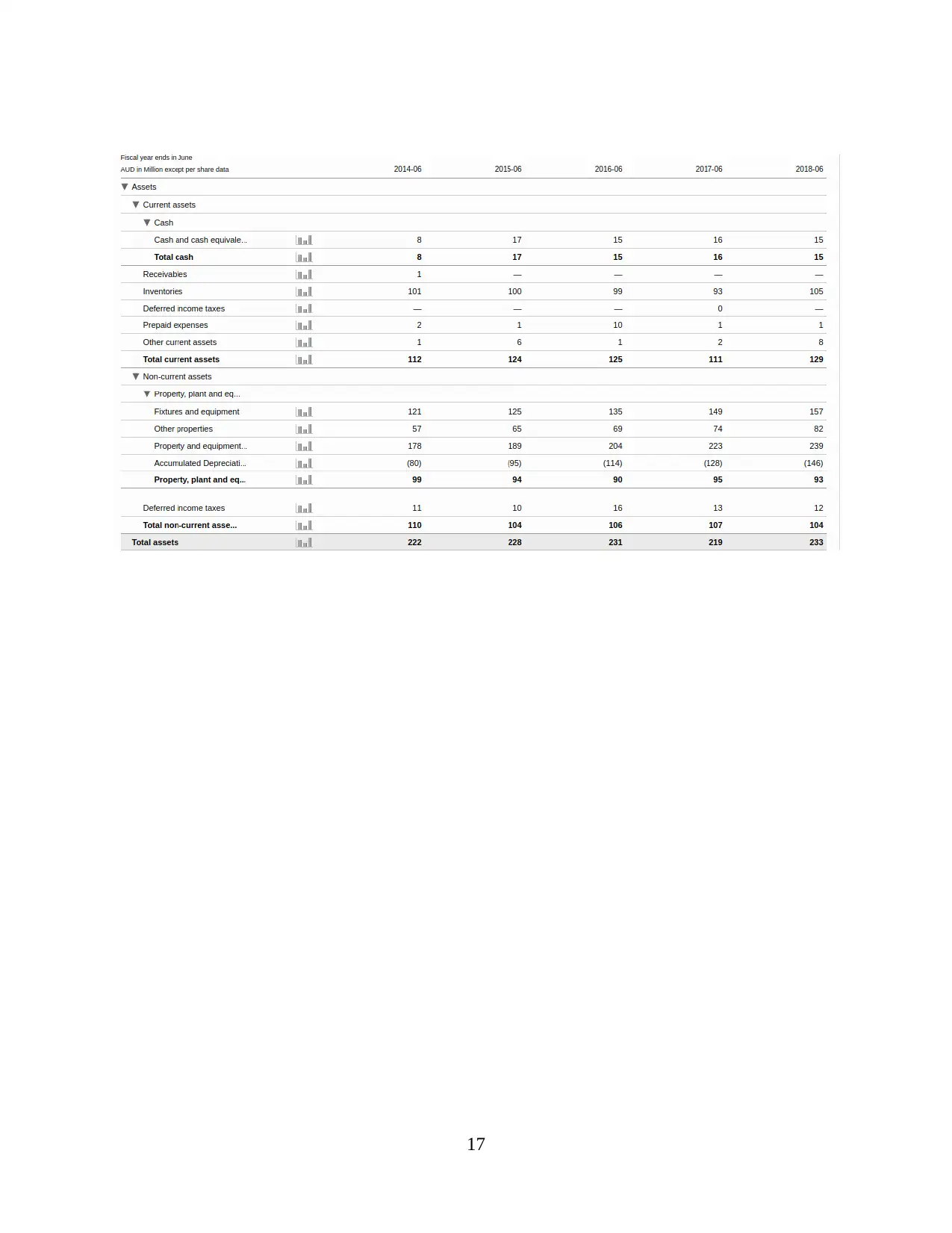
⊘ This is a preview!⊘
Do you want full access?
Subscribe today to unlock all pages.

Trusted by 1+ million students worldwide
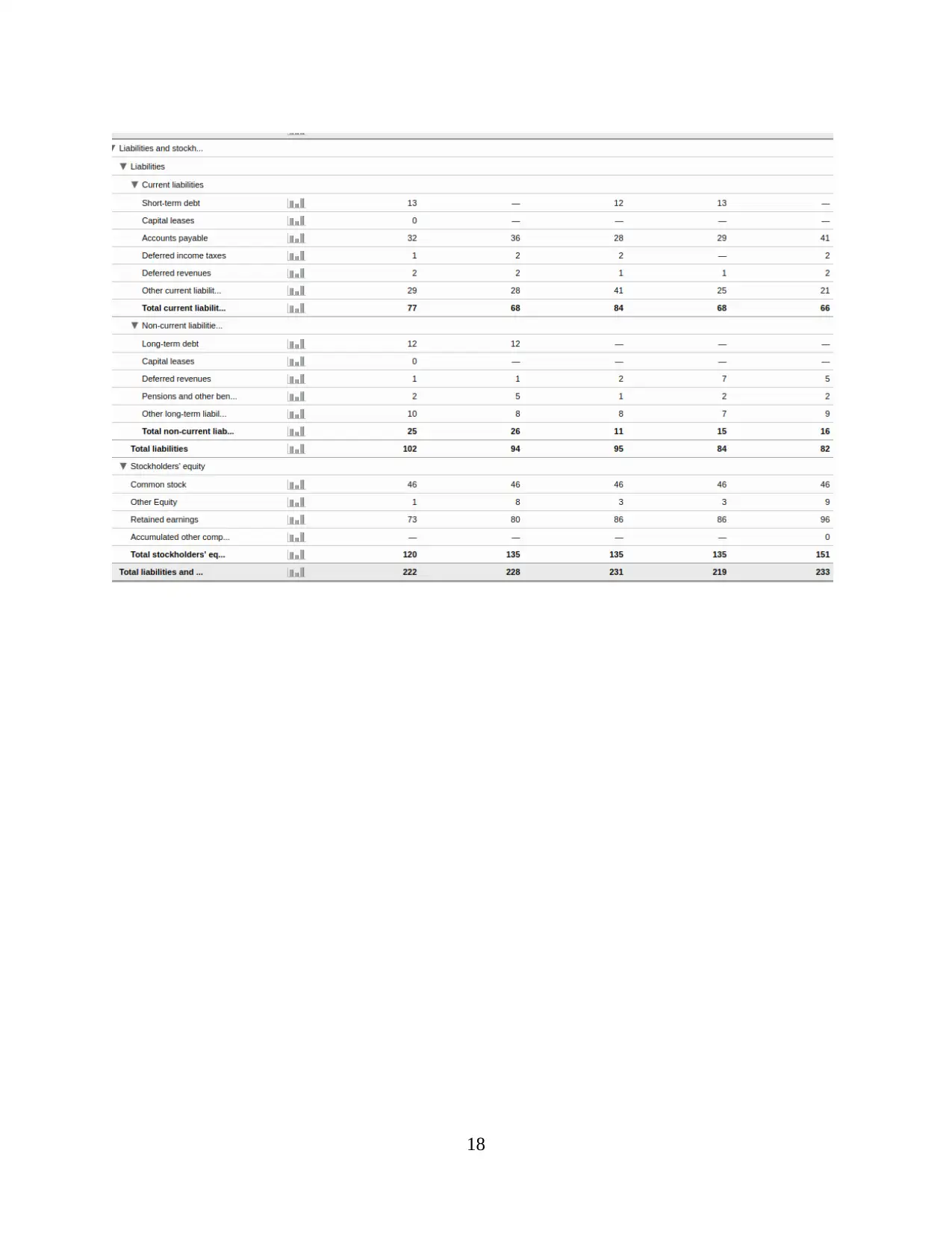
Paraphrase This Document
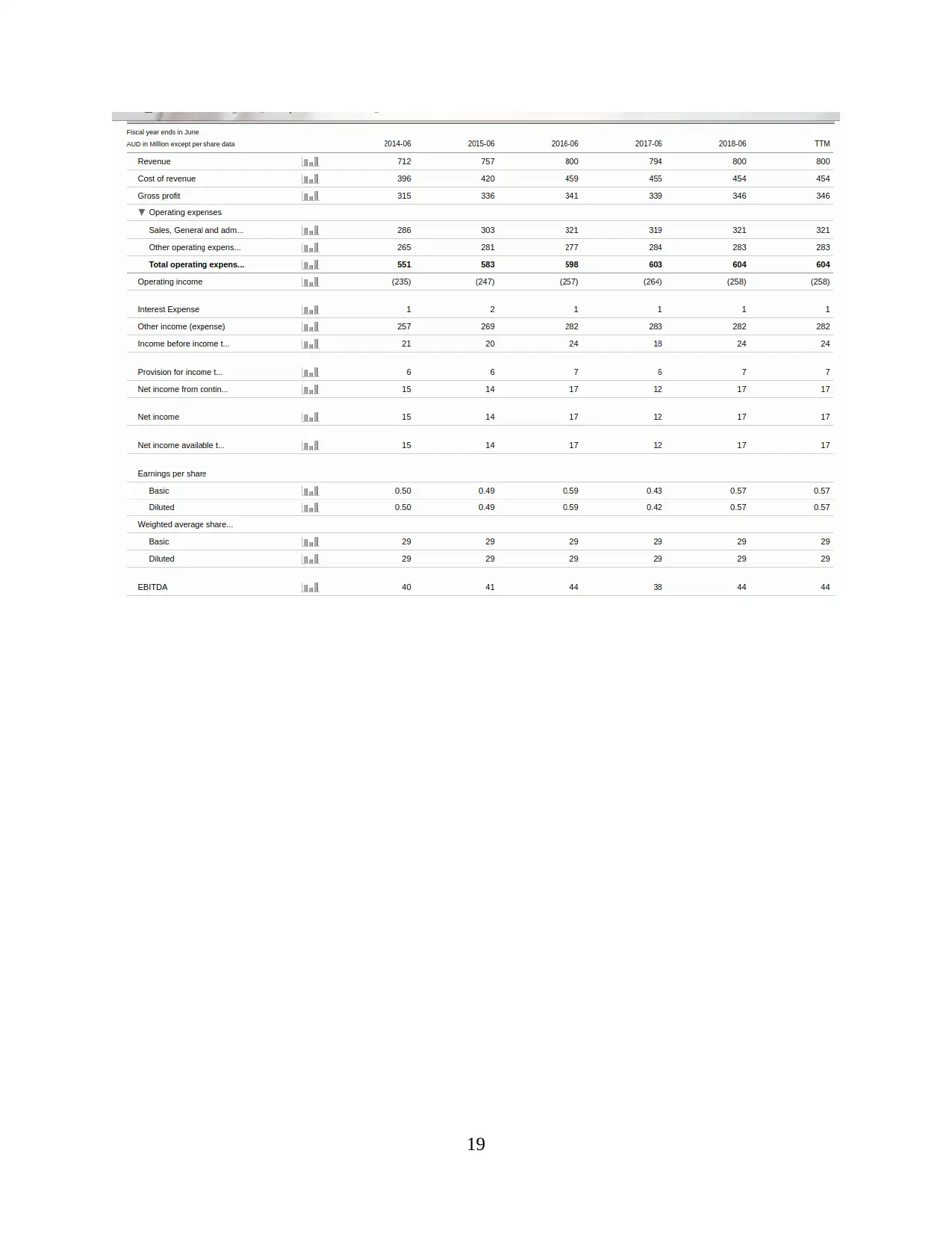
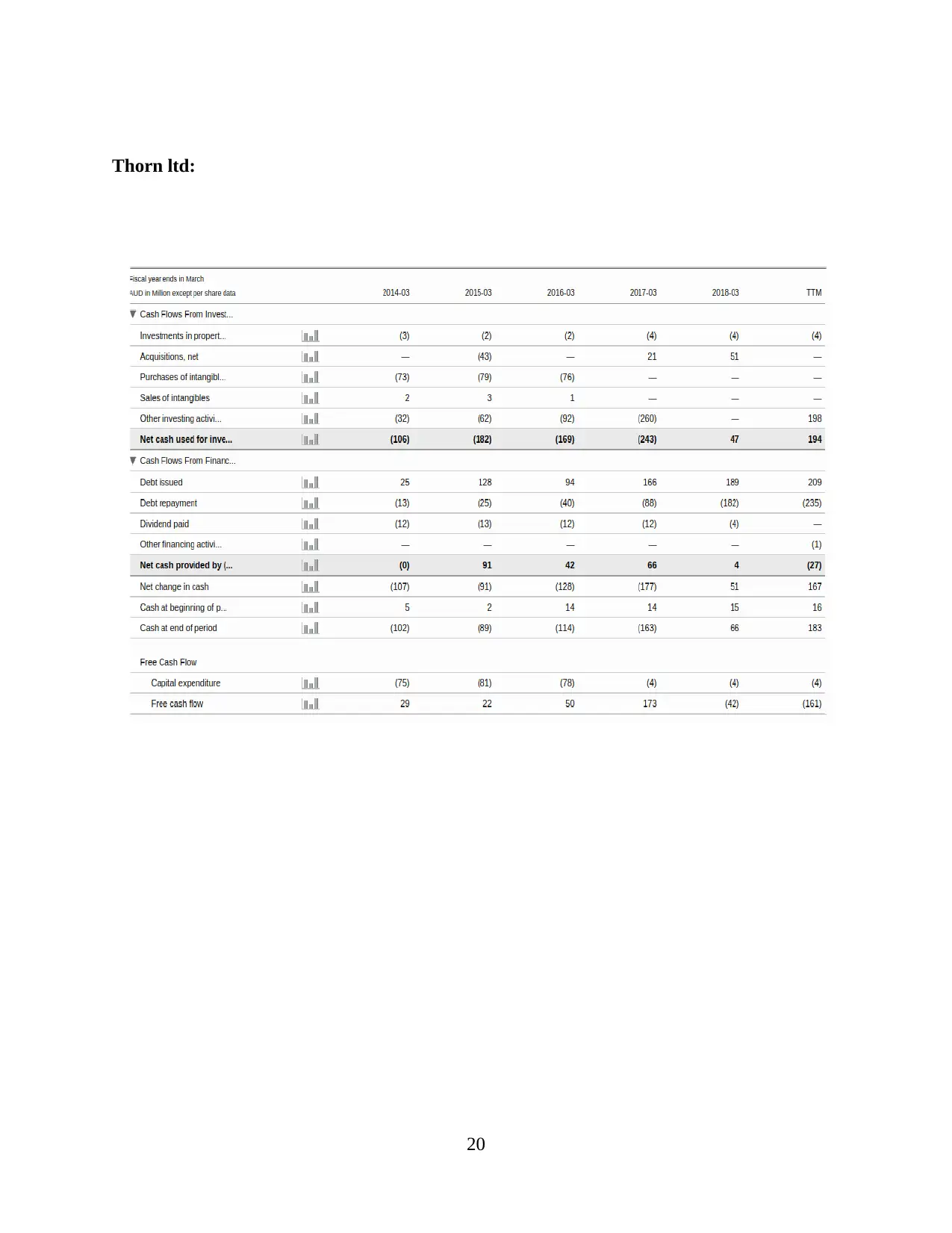
20
⊘ This is a preview!⊘
Do you want full access?
Subscribe today to unlock all pages.

Trusted by 1+ million students worldwide
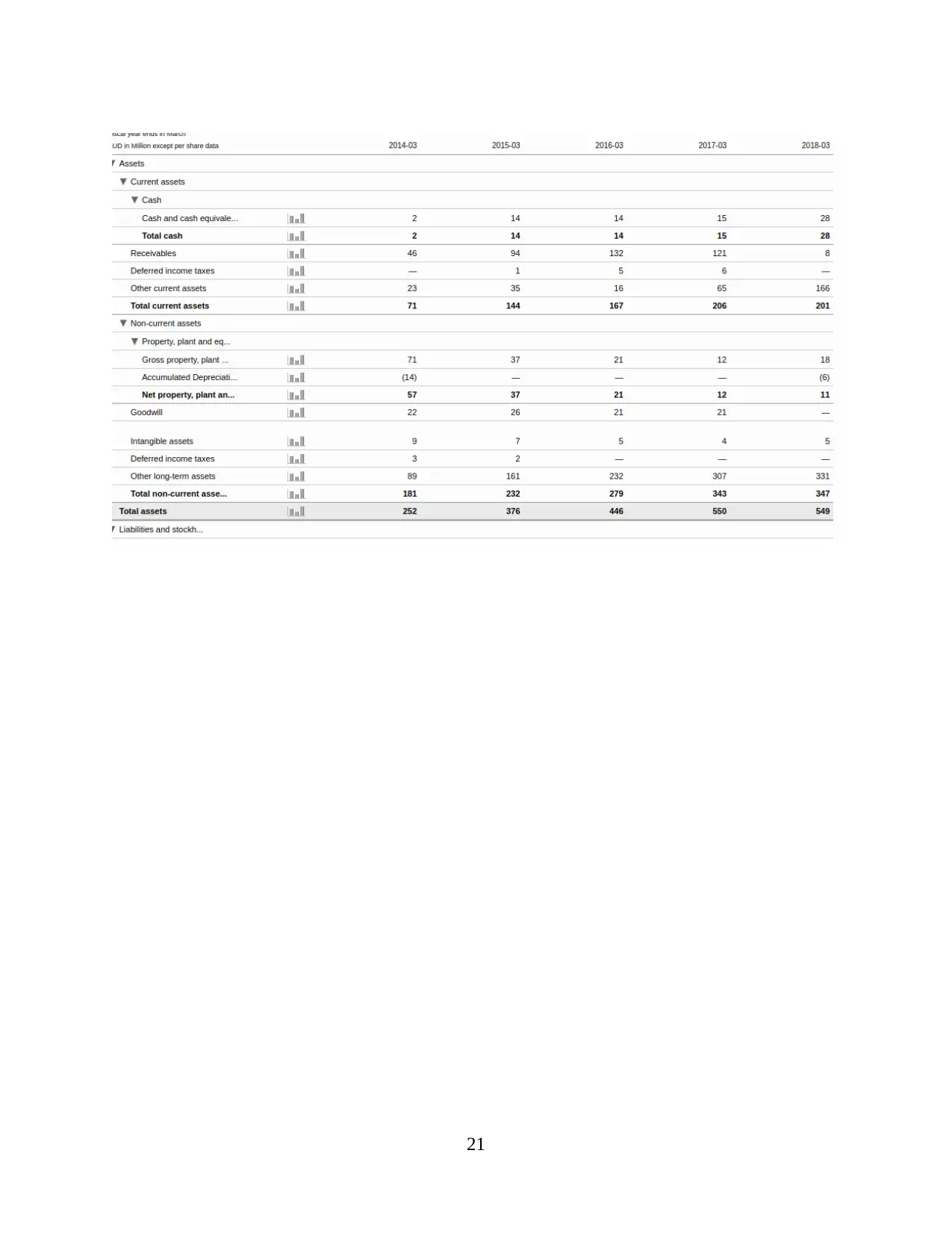
Paraphrase This Document
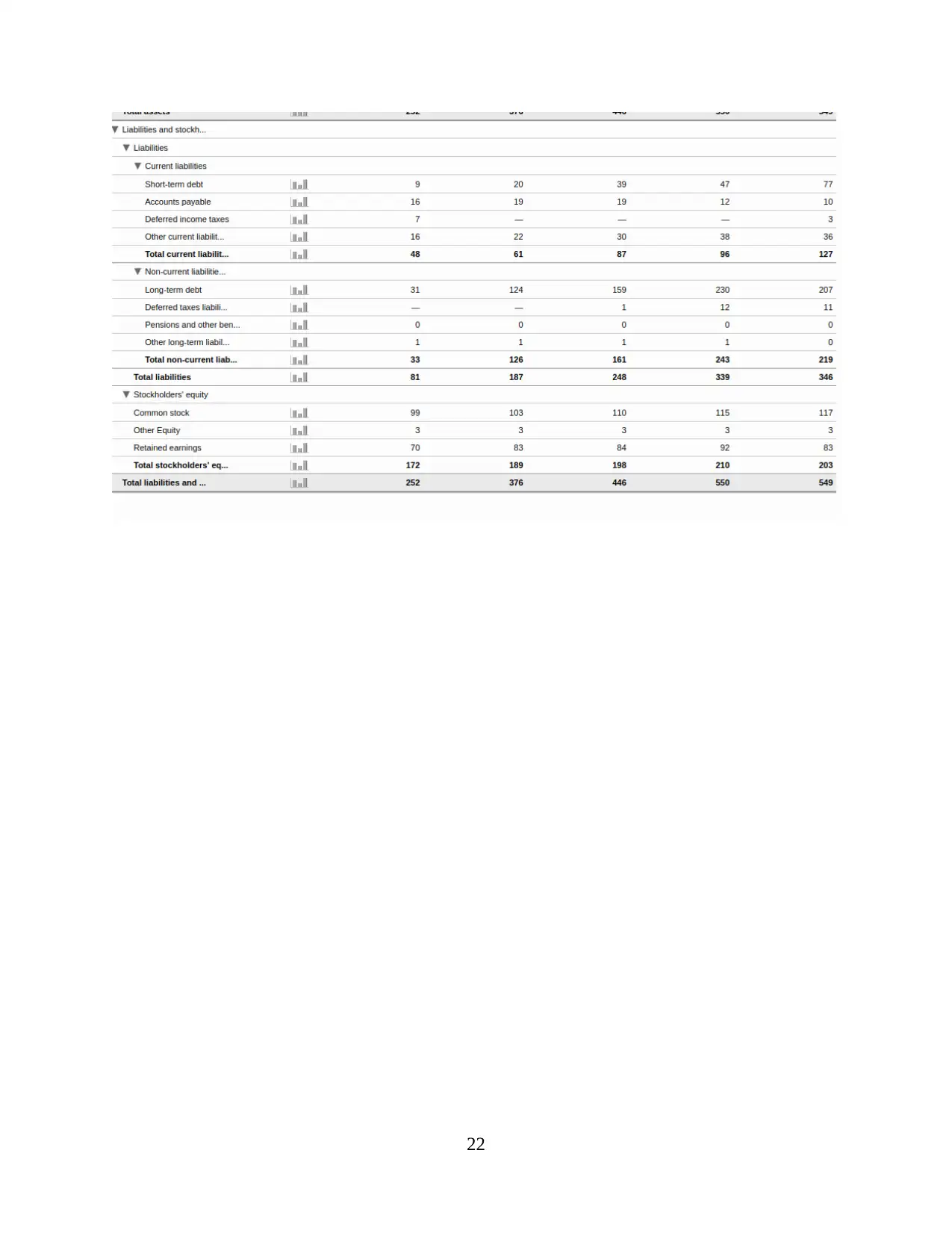
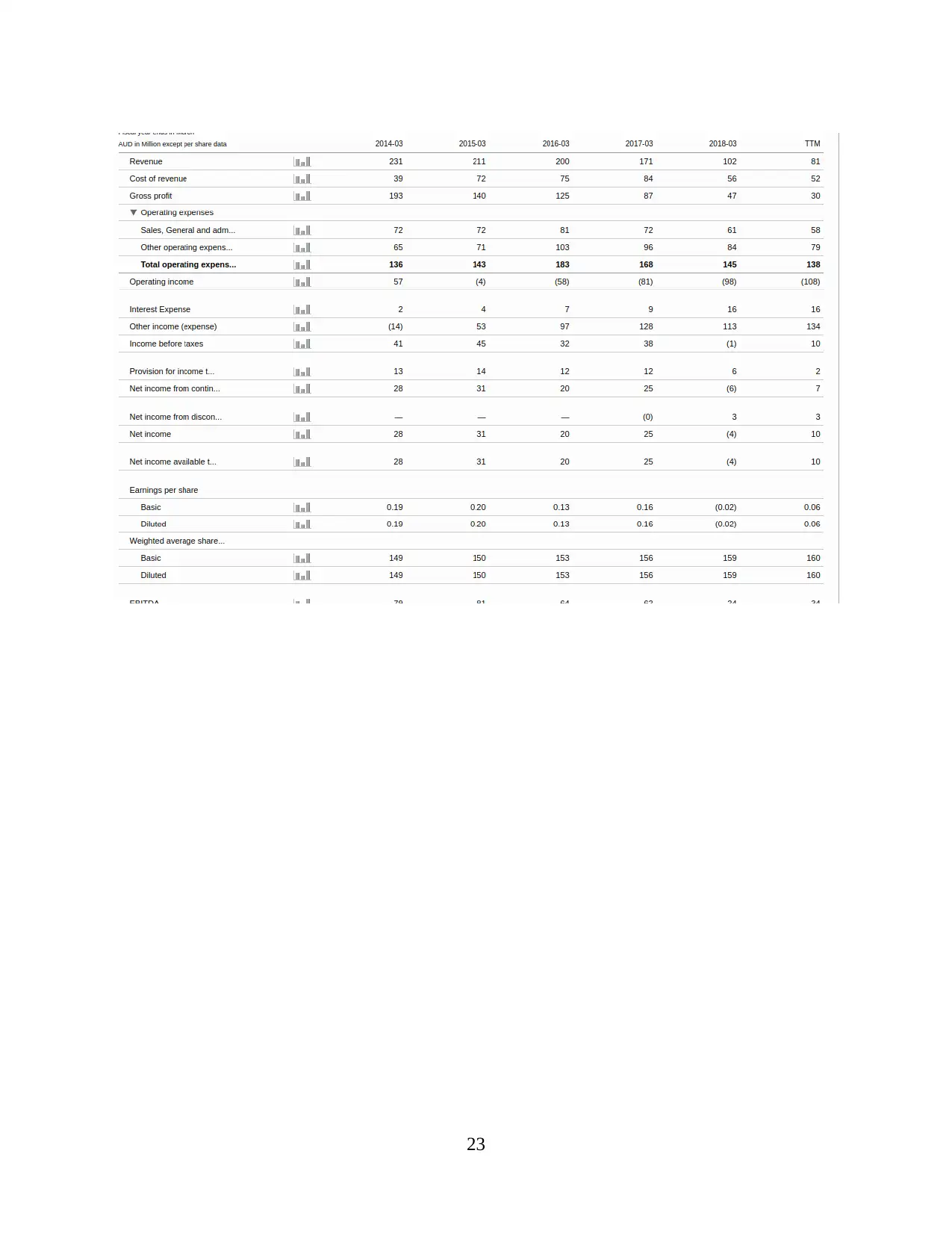
⊘ This is a preview!⊘
Do you want full access?
Subscribe today to unlock all pages.

Trusted by 1+ million students worldwide
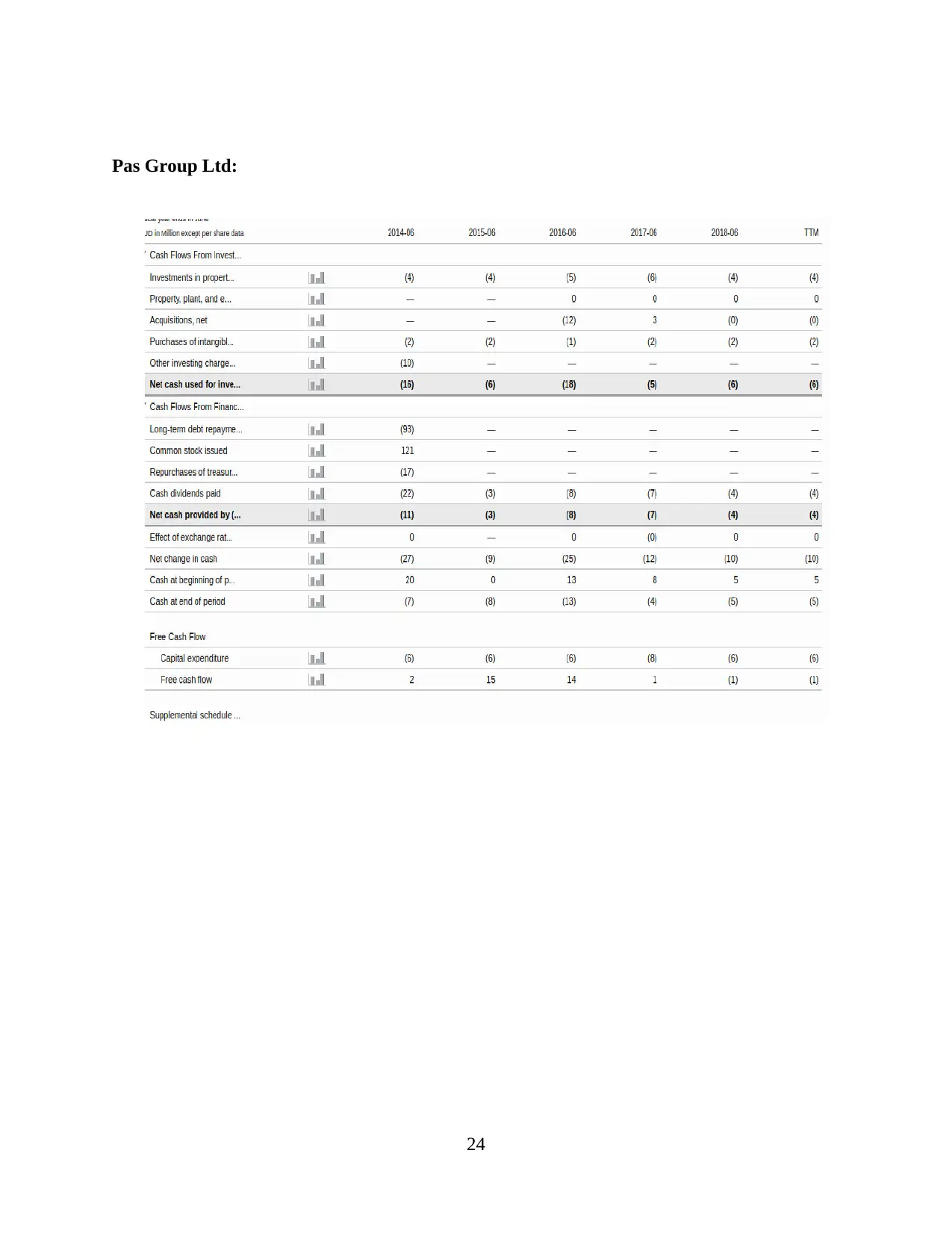
24
Paraphrase This Document
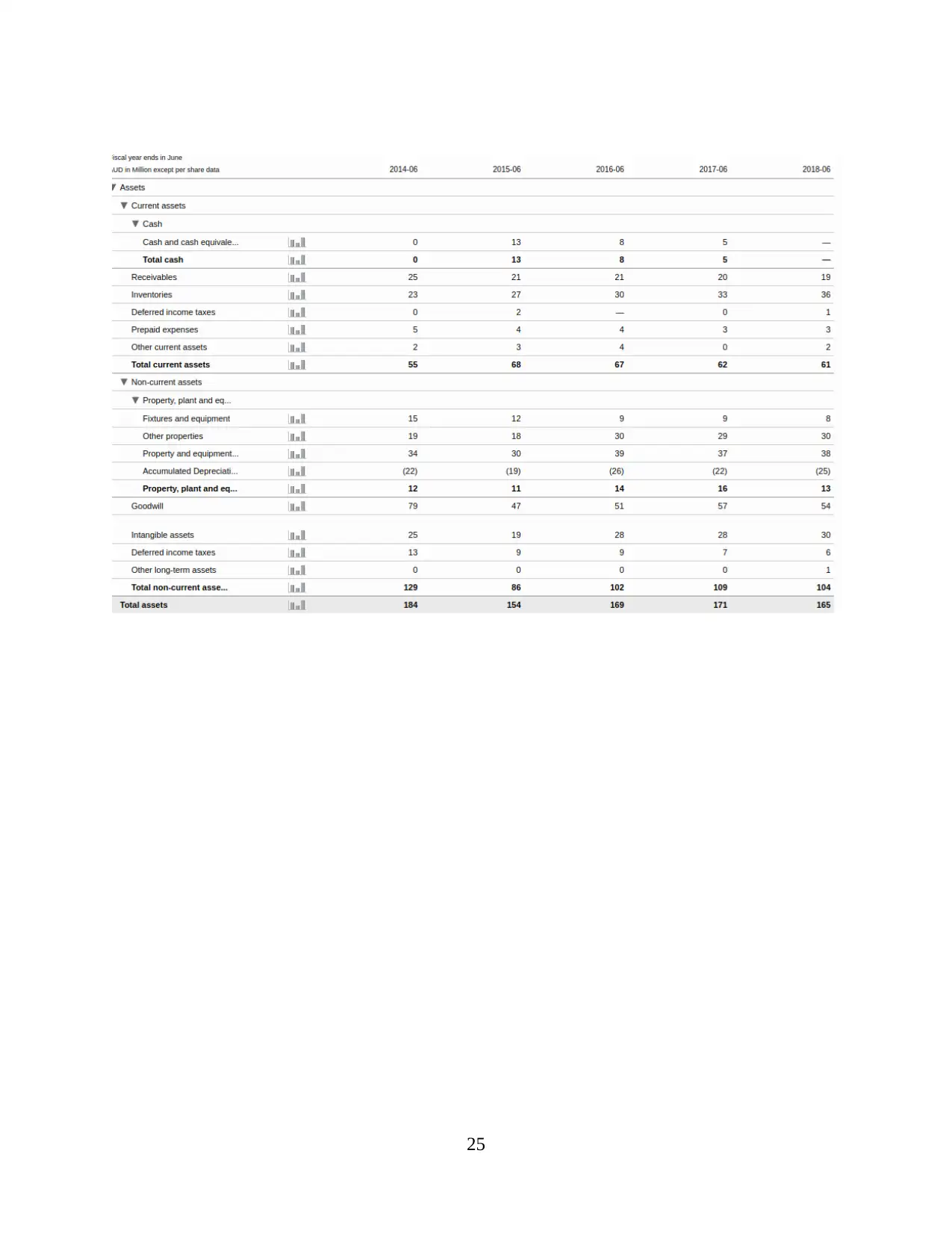
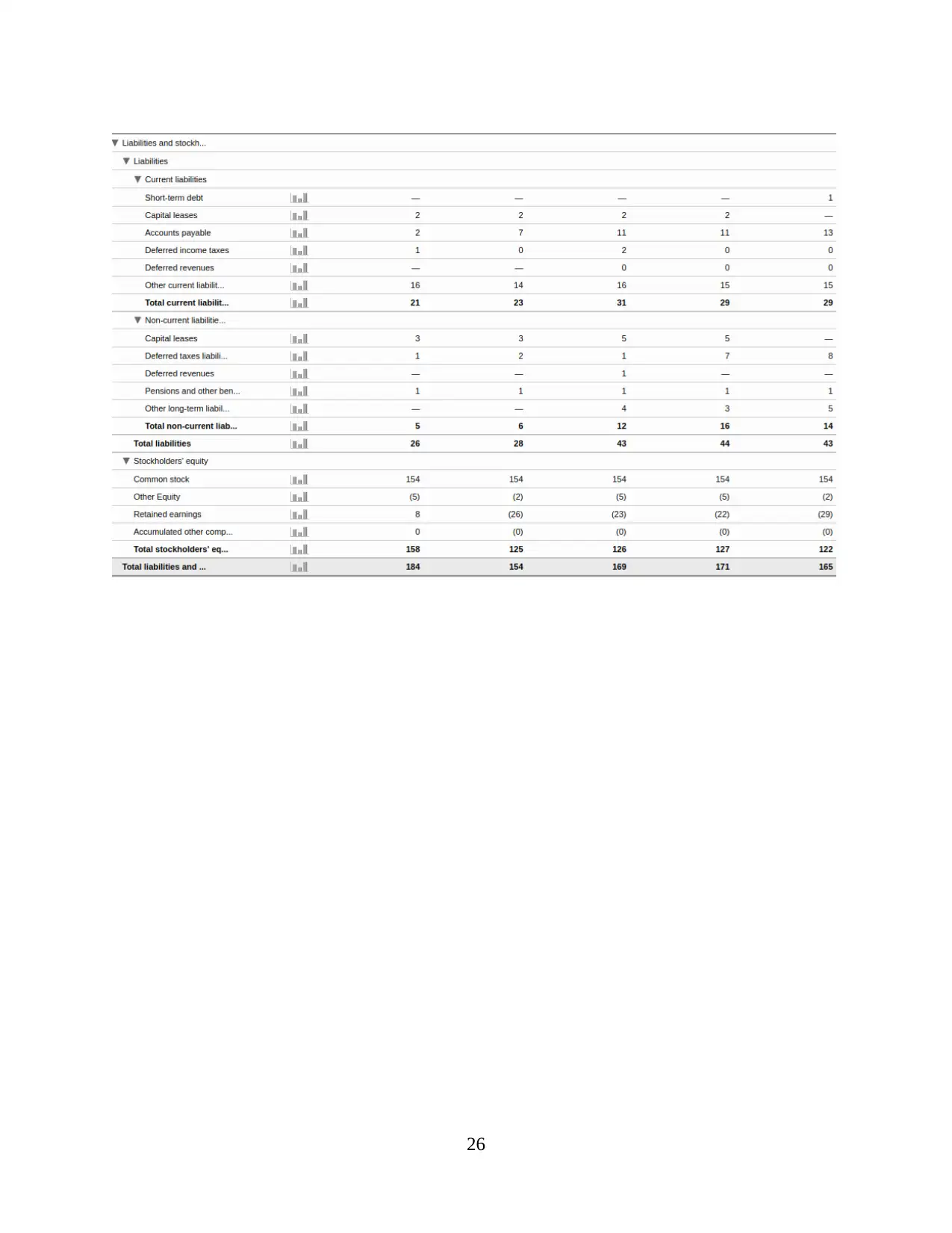
⊘ This is a preview!⊘
Do you want full access?
Subscribe today to unlock all pages.

Trusted by 1+ million students worldwide
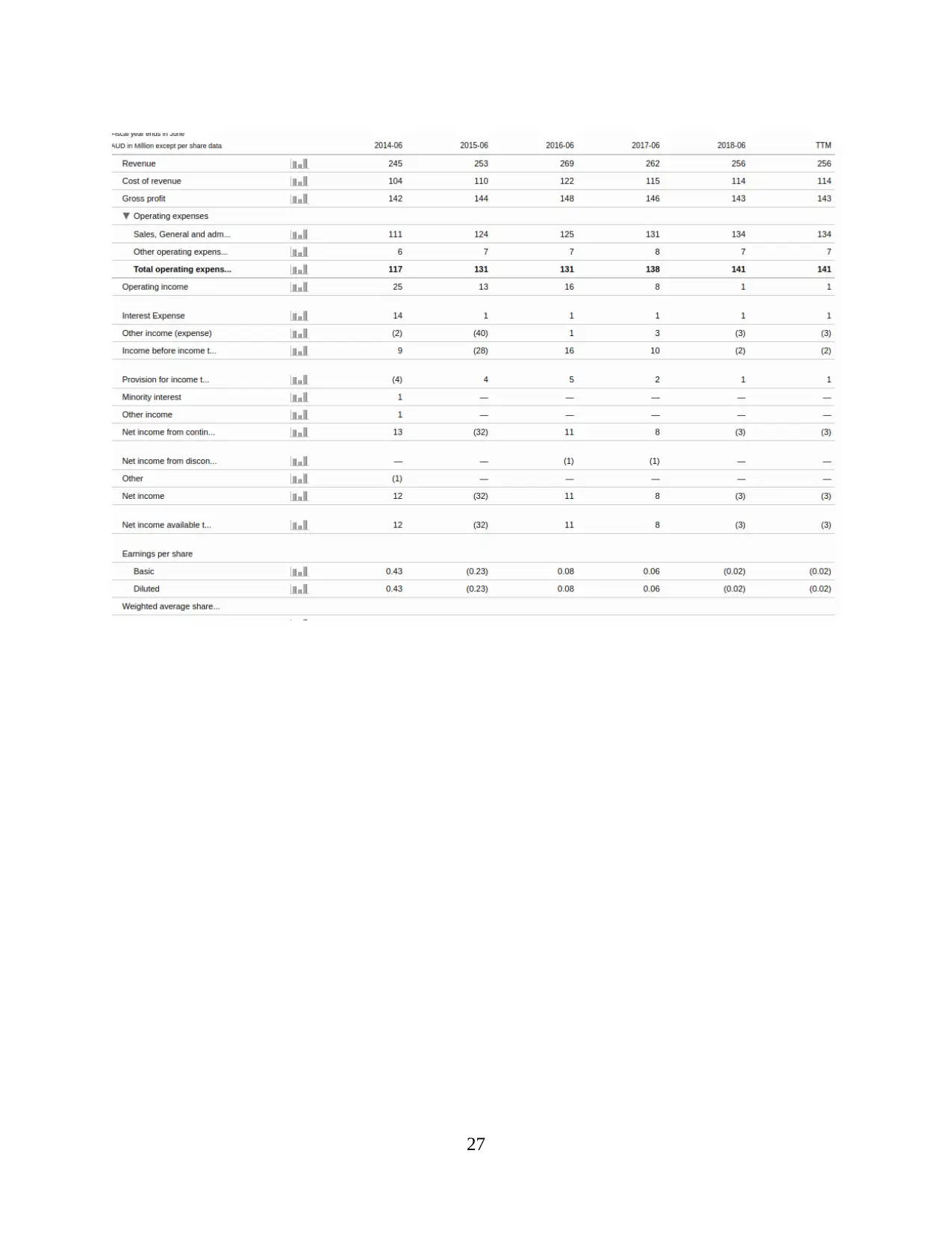
Paraphrase This Document
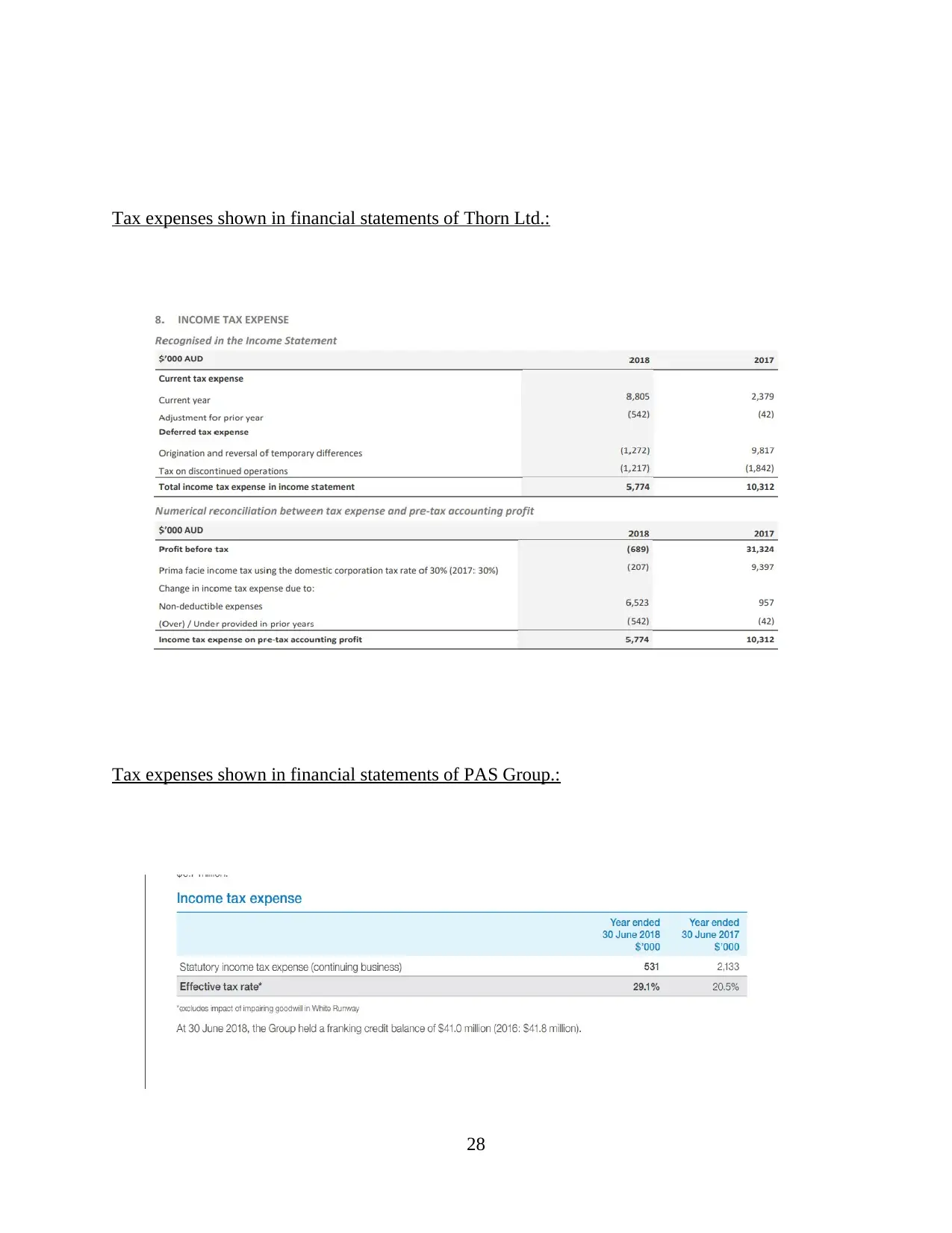
Tax expenses shown in financial statements of PAS Group.:
28
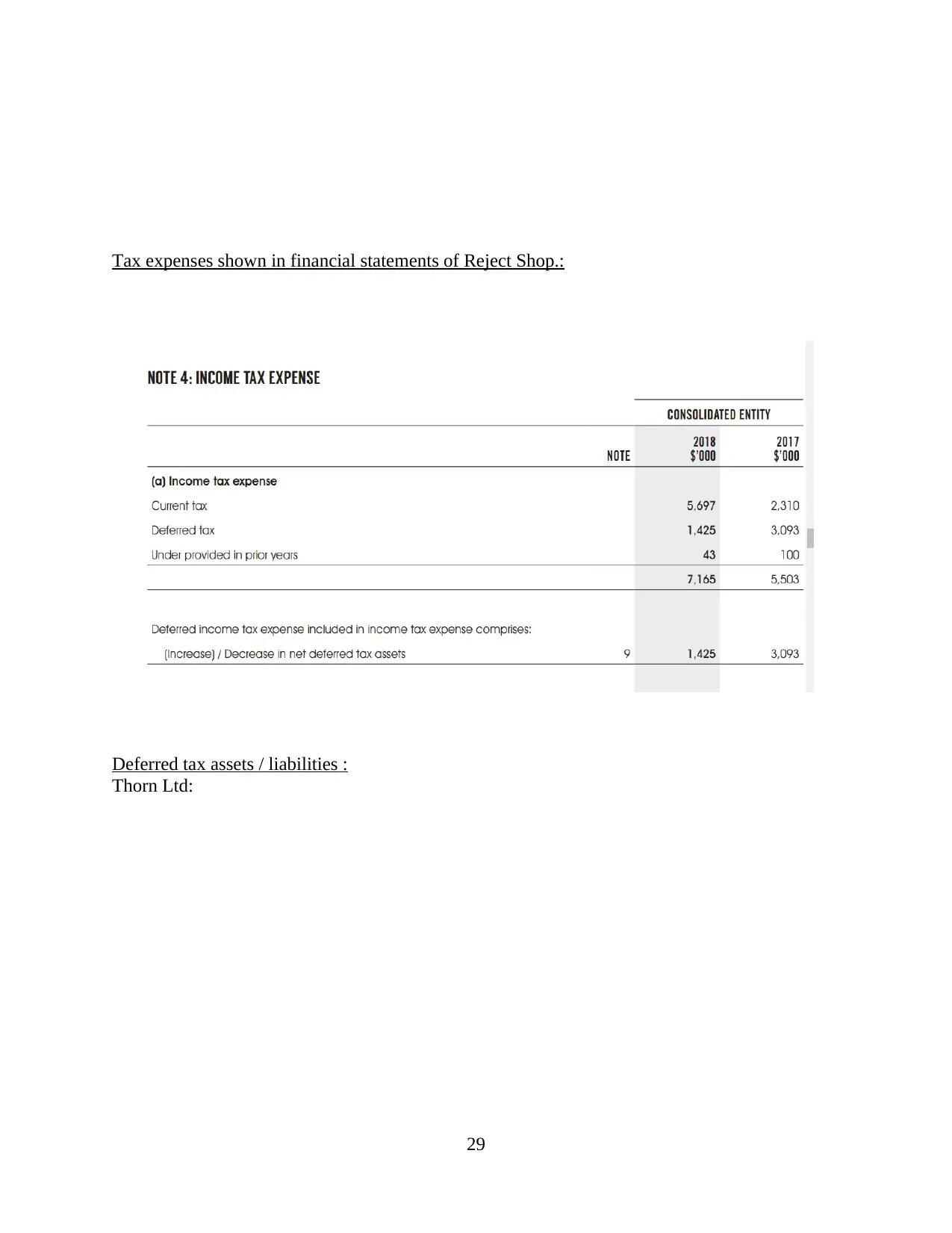
Deferred tax assets / liabilities :
Thorn Ltd:
29
⊘ This is a preview!⊘
Do you want full access?
Subscribe today to unlock all pages.

Trusted by 1+ million students worldwide
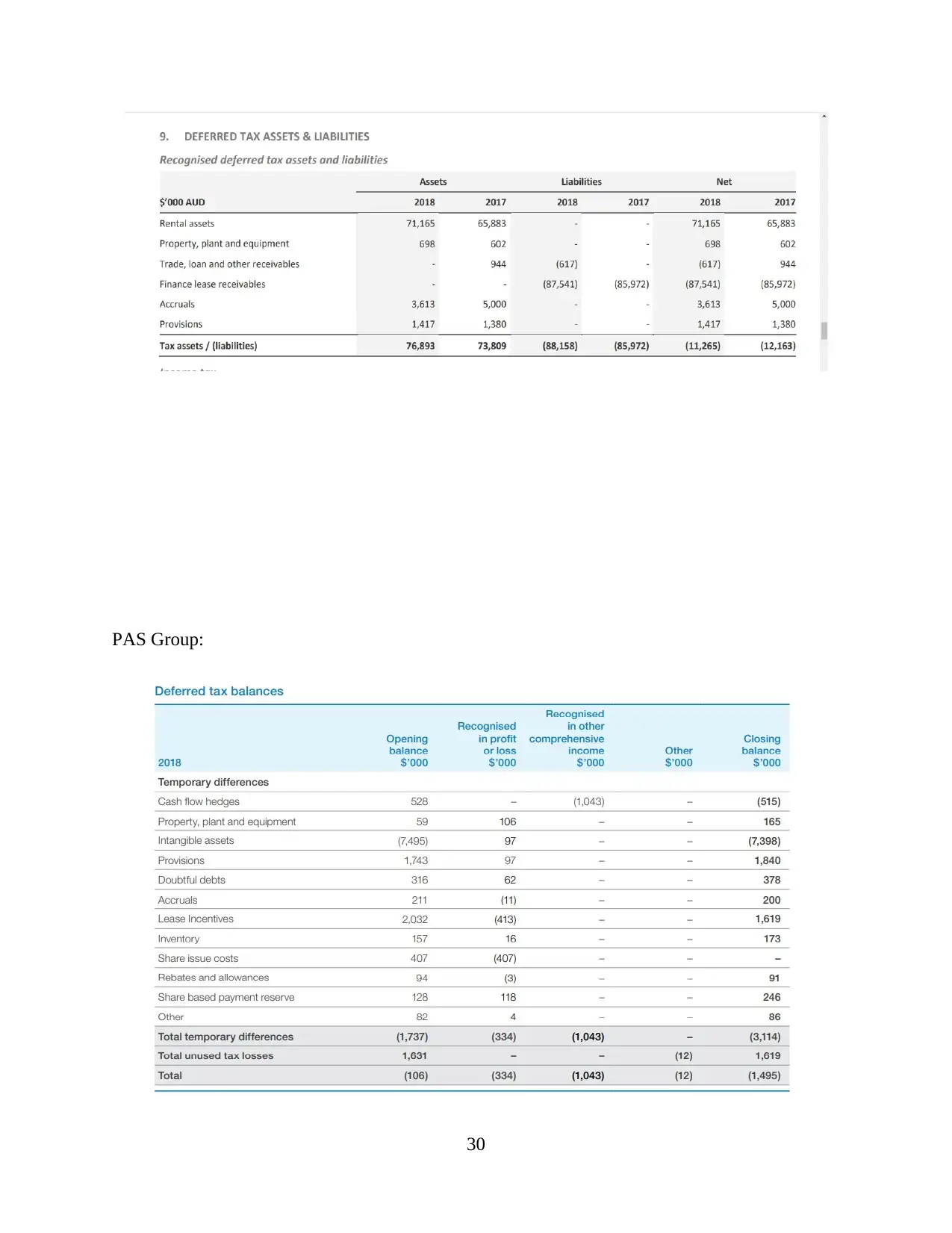
30
Paraphrase This Document
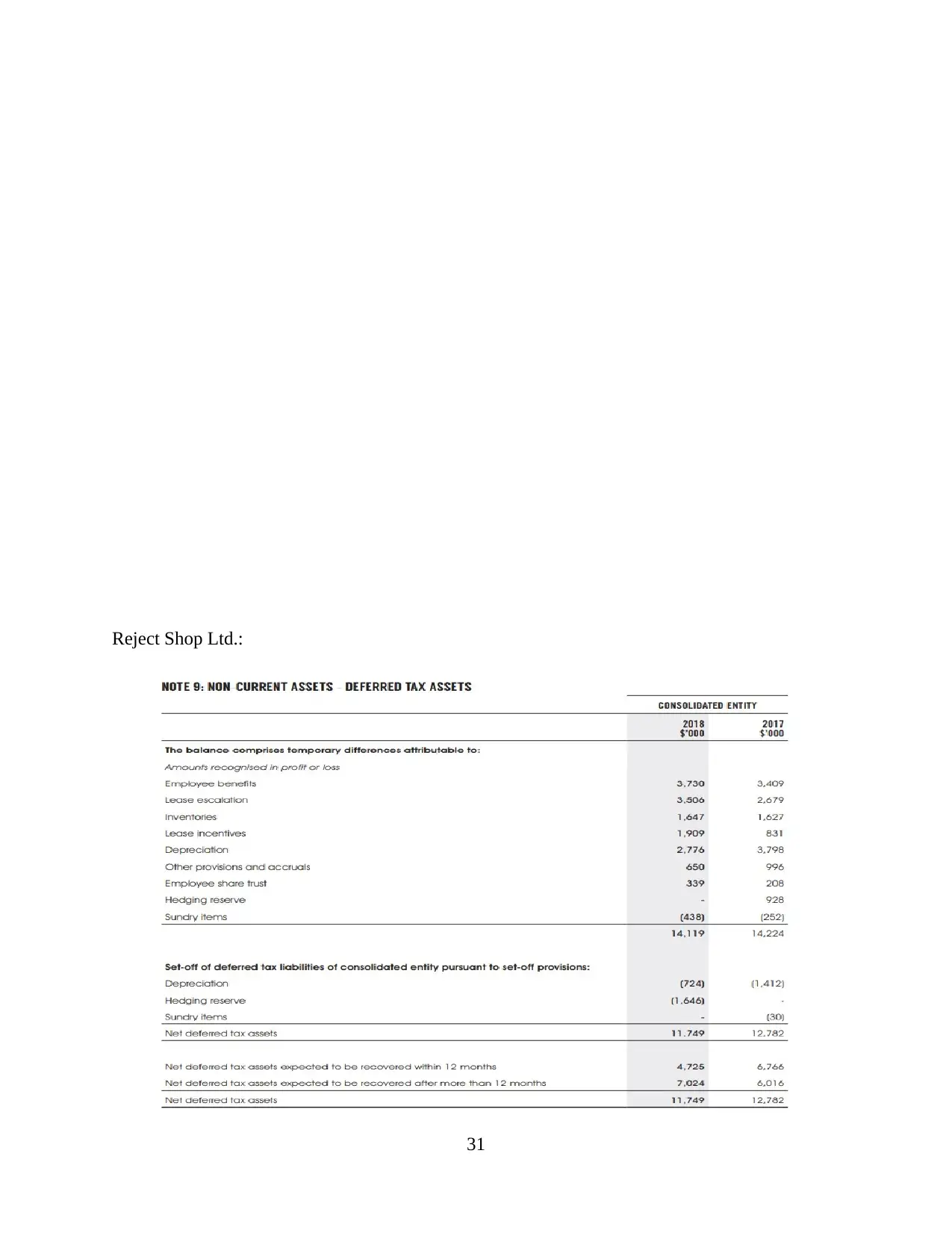
31

⊘ This is a preview!⊘
Do you want full access?
Subscribe today to unlock all pages.

Trusted by 1+ million students worldwide
Related Documents
Your All-in-One AI-Powered Toolkit for Academic Success.
+13062052269
info@desklib.com
Available 24*7 on WhatsApp / Email
![[object Object]](/_next/static/media/star-bottom.7253800d.svg)
© 2024 | Zucol Services PVT LTD | All rights reserved.





